-
Plant Name & Description
Botantical Name
-
Saffron Crocus Crocus sativus
The spice Saffron comes from this crocus as suggested in the name. When the plant blooms in the fall the stamens can be collected and used as dye and a spice. The small lavender colored flowers with yellow centers add a beautiful addition to the fall garden. Great when used in borders, rock gardens, and walkways.
-

Sallyrosa April Night Sage Salvia x sylvestris 'April Night'
This is a new small salvia that blooms a month earlier than older varieties. It has a very long bloom period, producing flowers from late spring all the way through summer until frost. The violet flowers on tall spikes bloom above compact upright foliage. It is a perennial that is easy to care for, just cut the whole plant back after the first bloom fades to encourage more flower growth.
-

Salmon Beauty Yarrow Achillea millefolium 'Lachsschönheit'
Long-flowering, spreading, mat-forming perennial. White to salmon pink flowers continue blooming throughout the summer. Fern-like foliage is slighty aromatic. Spreads easily by roots and by seeds. Grows well in many soil types but avoid especially heavy soils.
-

Samobor Dusky Cranesbill Geranium phaeum 'Samobor'
Rich maroon flowers are held high above the semi-evergreen foliage, which is deeply lobed and streaked with burgundy. This graceful perennial thrives in shady areas and brings elegant charm to informal woodland gardens.
-
Sand Sagebrush Artemisia filifolia
Freely branched, rounded shrub native to the Western United States. Slender, gray-green leaves provide a very soft texture. Prefers dry, coarse soils.
-

Sandwort Arenaria tetraquetra
This evergreen plant is low-growing with a cushion-like habit and small white flowers that cover the plant in late spring. It grows well in between step stones, on rock walls, or along borders. With its attractive foliage, this hardy plant provides year-round interest. This plant can be grown in either sun or part shade but requires a soil medium with good drainage to thrive.
-

Santa Fe Maximilian Sunflower Helianthus maximiliani 'Santa Fe'
Tall, autumn-blooming herbaceous perennial. One of the last perennials to bloom in the fall, and possibly one of the showiest. Golden yellow flowers bloom on stalks of beautiful green foliage. Will grow in any soil and will tolerate hot and dry conditions. Best used as a backdrop for other plants.
-
Santa Rosa Plum Prunus salicina 'Santa Rosa'
Deciduous fruit tree. Produces dark-red to purple, lightly freckled plums. Inner flesh is yellow suffused with pink. The fruit is firm, juicy, sweet, and aromatic. Partially self-fertile but produces more heavily with polinizing. Vigorous and productive fruit producer. This cultivar is resistant to some diseases. Requires deep regular watering.
-
Sapphire Blue Flax Linum perenne 'Sapphire'
Purple blue flowers bloom in early to mid-summer on compact stems. The small, thin leaves are almost grass-like and grow along the stems. This variety is more compact than the species and extremely cold tolerant. It works great in naturalized areas or meadows. It will re-seed, which is a desirable feature for this lovely plant.
-

Sarah Bernhardt Peony Paeonia lactiflora 'Sarah Bernhardt'
Clump-forming herbaceous flowering perennial. Very large fragrant double flowers are bright rose-pink and bloom in late-spring. Glossy green foliage is deeply lobed and provides interest even when out of bloom. Plant in fertile and well-drained soils. Tolerates some drought once established.
-
Saskatoon Serviceberry Amelanchier alnifolia
This suckering, deciduous shrub is native to the western United States and has a variety of uses. The rounded green have good fall color. Clusters of delicate pure white flowers bloom in spring. June brings sweet purple-black berries that are loved by birds. Of all the species of serviceberry this is the most popular for human consumption, being the most flavorful. The berries resemble large blueberries in both look and taste, and are good eaten raw or cooked into jams and pies. Tolerant of alkaline soils.
-

Scarlet Flame Phlox Phlox subulata 'Scarlet Flame'
This rock garden star blooms with masses of bright magenta flowers in the spring. The attractive carpet of foliage retains its presence into the summer.
-

Scarlet Letter Oak Quercus robur x alba 'Scarlet Letter'
A narrow, columnar oak tree with dramatic red fall color. Its dense and sturdy branches resist wind and snow damage and make for a great privacy screen when planted in a row. This hardy hybrid of the White Oak and the English Oak can handle poor or alkaline soils and prolonged heat.
-

Scarlet Meidiland Shrub Rose Rosa 'Meikrotal'
Large, spreading, shrubby rose. Numerous non-fragrant, scarlet red double flowers, up to 3" wide, bloom continually through the summer. Dark green ovate foliage is slightly tinged red. Resistant to disease. Makes a great landscape rose and provides excellent summer color. Plant in masses or in hedges. Very care-free.
-

Scarlet Penstemon Penstemon barbatus subsp. coccineus 'Scarlet'
This is penstemon is native to Utah and thrives in poor soil conditions. It is a clump-forming perennial with reddish-orange, two-lipped, tubular shaped flowers atop rigid stems blooming from late spring well into summer. The narrow, lance-shaped leaves resemble willow leaves. It likes inorganic mulch rather than compost.
-

Scentara Double Blue Lilac Syringa x hyacinthiflora 'SMNSHBBL'
Abundant clusters of bluish-purple, double-petaled flowers bring stunning fragrance in the spring. Excellent disease resistance and an elegant shape make this an easygoing and classic-looking shrub even after the spring blooms fade.
-
Scots Pine Pinus sylvestris
This large evergreen tree has a uniform pyramidal shape in youth but becomes more open and picturesque with maturity. Its cinnamon-red bark is ornamentally flaky. The needles of this pine are a green to grey-green and come in bundles of two and are shorter than many other pines. It will tolerate difficult soils and some drought but does best with moderate moisture.
-

Sea Green Juniper Juniperus chinensis 'Sea Green'
Compact vase-shaped arching evergreen shrub. Fine textured dark mint green foliage is scale-like but sharp when juvenile. Branches arch gracefully out from the base. Allow plenty of room to grow and spread. Very drought tolerant once established. Tolerant of alkaline and infertile soils.
-

Sea Kale Crambe maritima
A traditional salt-tolerant perennial from the coasts of Europe, sea kale also works well in the Intermountain West. Large, waxy blue-green foliage grows in large clumps. Small white flowers grow in clusters in the spring. The young shoots can be eaten as a vegetable, resembling asparagus or cabbage.
-

Sea of Gold Juniper Juniperus x pfitzeriana 'Monsan'
A compact, evergreen shrub with feathery, yellow-gold foliage. It retains its gold color better than other junipers even deepening in the winter. Once established, it handles difficult soils and drought very well.
-
Sea Thrift Armeria maritima
Neat evergreen tufts of green grass-like foliage grow on woody stems that spread along the ground, forming a soft carpet. In spring, a profusion of 1" wide spherical pink flower heads create a "sea" of pink. Deadheading will extend flowering time. Makes a great groundcover for sunny open areas, but can't handle very much foot traffic.
-

Sebastian Maas Peony Paeonia lactiflora 'Sebastian Maas'
Clump-forming herbaceous flowering perennial. Large, highly fragrant pink flowers are semi-double with serrated edges and outer petals which fan out. Flowers bloom in late-spring. Attractive glossy green foliage is deeply-lobed. Plant in fertile well-drained soils. Tolerates some drought once established.
-

Seckel Pear Pyrus communis 'Seckel'
Small, deciduous, fruit-bearing tree. Pure white flowers bloom in mid-spring turning to small, yellow-brown fruits with red blush that ripen in September. Also called candy pear or sugar pear, this pear variety makes an excellent dessert pear. Requires moderate amounts of water to support fruit growth. Pruning and pest control are required on fruit trees. This variety is resistant to fire blight.
-

Select Blue Catmint Nepeta x faassenii 'Select Blue'
Attractive and long-blooming member of the mint family. Covered with lavender blue blossoms starting in late spring and will rebloom in the late-summer if deadheaded promptly. The fragrant gray-green foliage is attractive and will provide interest even out of bloom. This variety is sterile and so is not as aggressive as other catmints. A great choice for any low-water landscape.
-

Sensation Boxelder Acer negundo 'Sensation'
The leaves of this hardy tree emerge copper red, fading to green with red highlights in the summer then turning bright red in the fall. It is highly adaptable to site conditions including wet or dry soils. It's form is pyramidal in youth then spreading with age, with a single silvery trunk. This seedless variety is less attractive to boxelder bugs.
-

Sensation Lilac Syringa vulgaris 'Sensation'
Upright growing deciduous shrub. Panicles of fragrant lavender-purple, white edged flowers bloom in spring. Green cordate leaves have no fall color. Tolerates many soil types but no extremes. Quite drought tolerant once established.
-
Serbian Spruce Picea omorika
Narrowly pyramidal evergreen conifer. One of the best spruces for the landscape due to its tolerance of urban conditions. Dark green needles have light colored stomatal stripes. Graceful branches grow all the way to the ground. Said by some to resemble the Douglas Fir. Bark is reddish-brown. Cones are roughly egg-shaped. Prefers moist, fertile soils but is tolerant of other conditions.
-
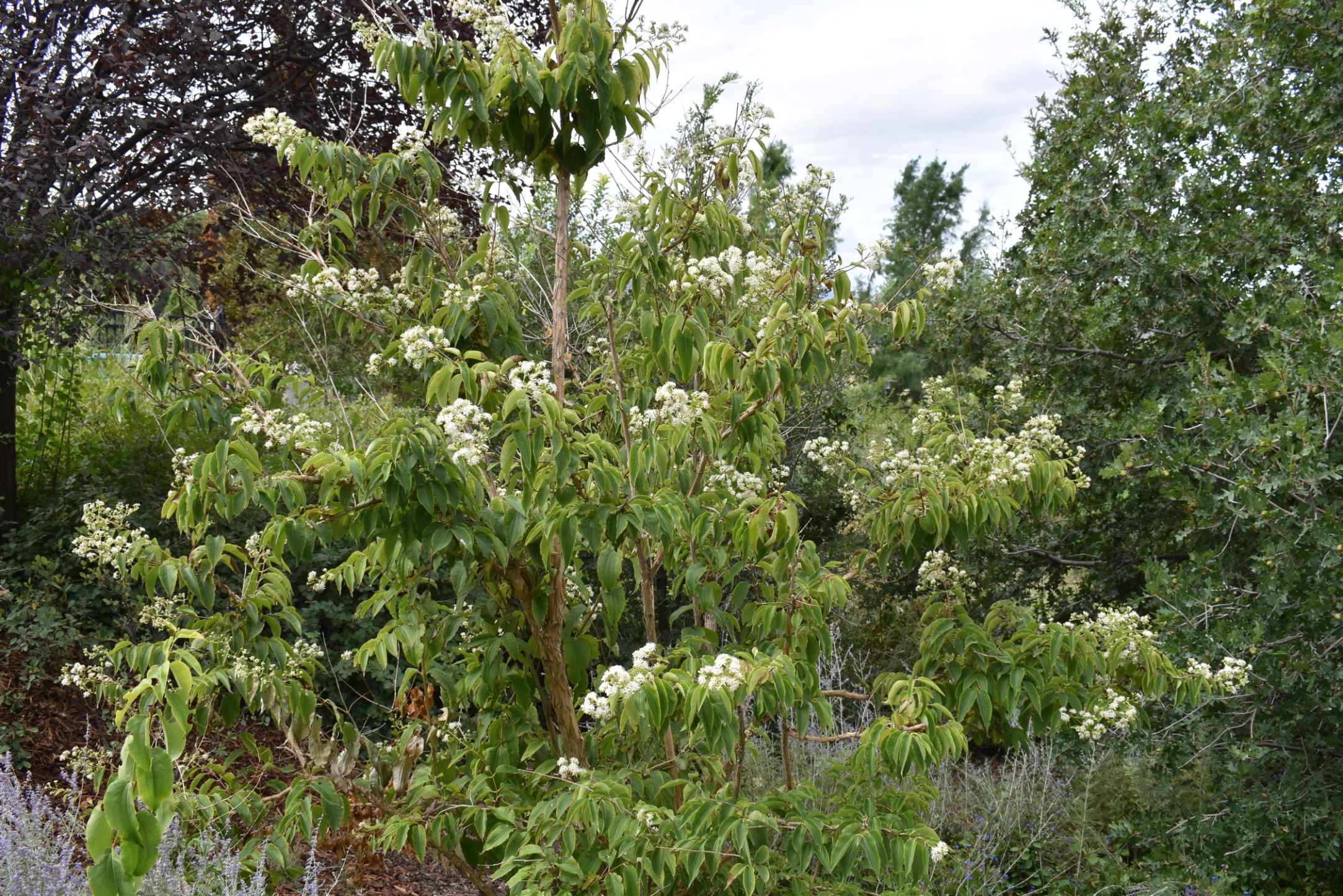
Seven Son Flower Heptacodium miconioides
Large deciduous shrub native to China. Clusters of fragrant white flowers are grouped in clusters of seven and bloom in late-summer to fall. As the blossoms gently fall to the ground they reveal vivid red, fan-like bracts. These bracts act as a second wind of colorful interest, looking like blossoms in an all new color. Usually grown with multiple stems, but it can be trained to grow on one trunk. Green leaves are simple and 2-6" in length. Exfoliating tan bark is attractive and adds to the overall beauty of this plant. Not particularly drought tolerant.
-

Shademaster Honeylocust Gleditsia triacanthos f. inermis 'Shademaster'
A medium-sized shade tree with an excellent vase shape and finely-spaced upward branches. Although the species has thorns and large pods, this variety is thornless and typically won't produce pods. The leaves are fernlike and composed of numerous leaflets, creating light dappled shade and making fall clean-up easy. The green rounded leaflets have serrated edges and will turn yellow in autumn. Flowers are yellow and insignificant. Very tolerant of dry and compacted soils as well as periods of drought and excess moisture.
-

Shadow Mountain Penstemon Penstemon x mexicali 'Psmyers'
A beautiful hybrid penstemon with constantly blooming small, lavender pink flowers through out the summer. Narrow, lance-shaped, bright-green foliage is semi-evergreen. Prefers full sun and moist, well-drained soil. Attracts hummingbirds and butterflies and is deer resistant.
-
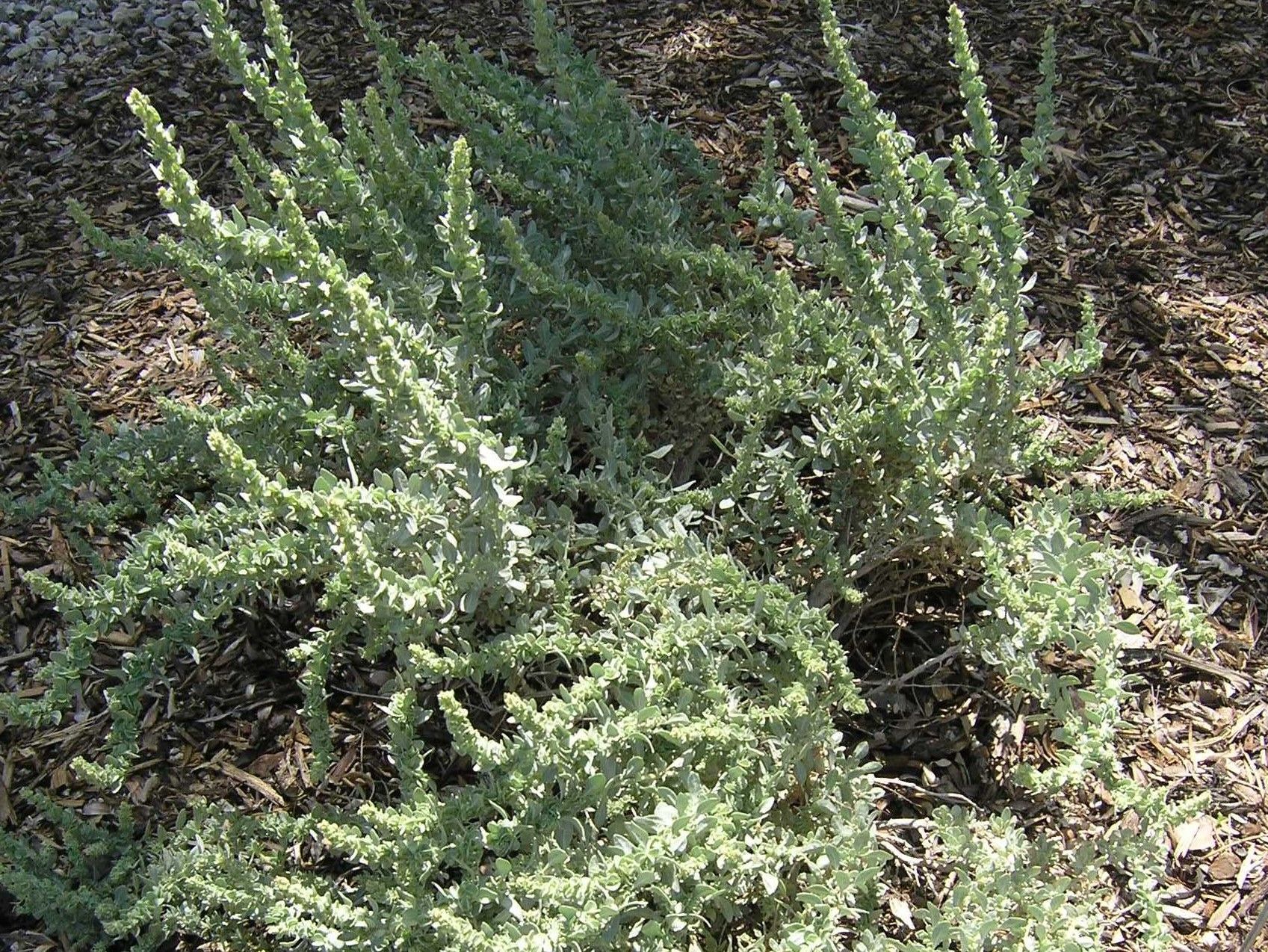
Shadscale Atriplex confertifolia
Upright-growing shrub native to Utah. Gray-green leaves have been described as looking like "cornflakes on a stick." Leaves turn salmon-peach in the fall and winter. Flowers bloom in late-spring to summer and are inconspicuous. Very tolerant of salt and drought. Will not tolerate over-watering.
-

Shaggy Dog Eastern White Pine Pinus strobus 'Shaggy Dog'
This dwarf, wide spreading white pine is unique in its overall growth habit. Branches spread out both upwards and downwards, creating the “shaggy dog” look that lead to this evergreen’s name. The foliage is mid green and shorter in size compared to others within the species.
-

Shangri-la Sage Salvia indica x moorcroftiana
Shangri-la Sage offers wide, sturdy leaves that have an appealing shade of grey-green. Flower stems rise high above the foliage with showy lavender-blue blossoms. The uniquely shaped flowers have a pale blue lip which is tinged and spotted with purple accents. Perfect for informal xeric or rock gardens.
-

Shasta Daisy Leucanthemum x superbum
Clump-forming perennial with dark green, lance-shaped foliage. Large, solitary, white flowers with yellow centers bloom in early to late summer. Prefers well-drained, moist soils. Tolerates some drought. Very showy, suitable for most landscape situations.
-
Shawnee Brave Bald Cypress Taxodium distichum 'Shawnee Brave'
This tall, conical, cone-bearing tree grows more narrow and with denser foliage than the species. This conifer loses its needles in the fall and winter, making it deciduous. The species grows naturally in swampy areas but will tolerate less water and somewhat dry conditions. It prefers acidic soil and should not be planted in soils with a pH higher than 7.5. Attractive light to mid green needles are quite flat and turn a bronze brown in the fall before falling off the tree. The base of the trunk is quite broad, even in youth and may form knobby "knees" in especially wet areas.
-

Shenandoah Switch Grass Panicum virgatum 'Shenandoah'
The foliage of this switchgrass cultivar emerges blue-green but turns burgundy with age. It has a tight upright form that resists flopping. It is tolerant of many types of soil and amounts of water. It will tolerate some shade. The species is native from Utah to the east coast.
-
Shepherd's Warning Bloody Cranesbill Geranium sanguineum 'Shepherd's Warning'
Vibrant pink flowers emerge from thick mats of deeply cut foliage, shining in mass plantings or borders. The semi-evergreen foliage and long-blooming flowers bring lush color earlier and longer than most plants.
-
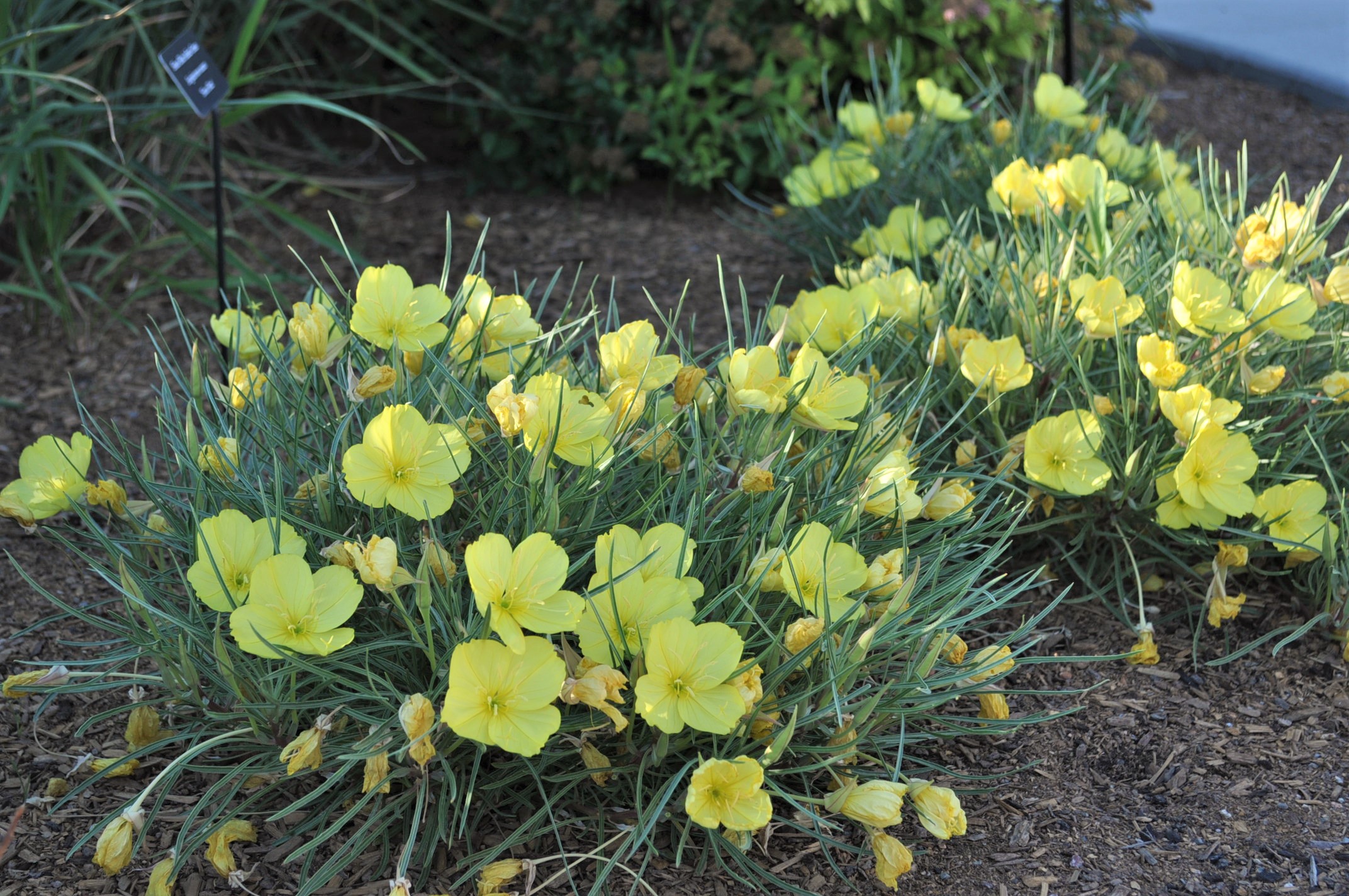
Shimmer Evening Primrose Oenothera fremontii 'Shimmer'
The narrow leaves of this variety create fluffy mounds of silvery-gray foliage. In the spring a burst of three inch bright yellow flowers start off the season with more sporadic blooming through the summer. This variety is drought tolerant and adapted to the soils of the Intermountain region.
-

Shirley Temple Peony Paeonia lactiflora 'Shirley Temple'
Clump-forming herbaceous flowering perennial. Large fragrant white double flowers blushed with pink bloom in late-spring. Flowers are excellent for cutting. Deeply lobed glossy green foliage provides attraction even when out of bloom. Plant in fertile well-drained soils. Tolerates some drought once established.
-

Shirley's Joy Hens and Chicks Sempervivum 'Shirley's Joy'
Low-growing perennial succulent with rosettes of thick pale green-gray leaves covered with a fuzz of soft white hairs. Leaf tips turn red seasonally. After blooming pale pink in summer, the rosettes will die but are replaced by new offset rosettes. Plants require excellent drainage and little water. Avoid excessively wet winter soil. Great choice for rock gardens, crevices, or well-drained pots.
-

Showy Goldeneye Viguiera multiflora
One of Utah's native plants, this one provides cheery summer color and works well for informal native or prairie plantings. It will flower the first year, and the small, golden, daisy-like flowers will continue from July to September. Under ideal conditions it can be aggressive, but it is easily controlled.
-

Showy Milkweed Asclepias speciosa Torr.
Showy Milkweed is a common native wildflower that serves as a host plant for Monarch butterflies. The caterpillars feed on the large oval leaves while the mature butterflies drink the nectar from the flowers. Due to a substance in the plants, Monarchs become toxic to their predators. In late spring and early summer, the flowers form interesting spiky spheres in shades of pink. In the fall, large seed pods break open to release clouds of fluffy seeds. Spreads easily by underground rhizomes and from seed; here in the Garden it is confined to certain areas so as not to invade the rest of the Garden.
-

Siberian Bugloss Brunnera macrophylla
This clump-forming perennial spreads by self-seeding and rhizomes, eventually forming a mat of green, heart-shaped foliage. Clusters of flowers that resemble those of the forget-me-not appear in early-spring. The common name, "bugloss," is derived from the Greek word for ox-tongue and is in reference to the rough texture of the leaves. This bugloss prefers to grow in shade and is intolerant of drought.
-
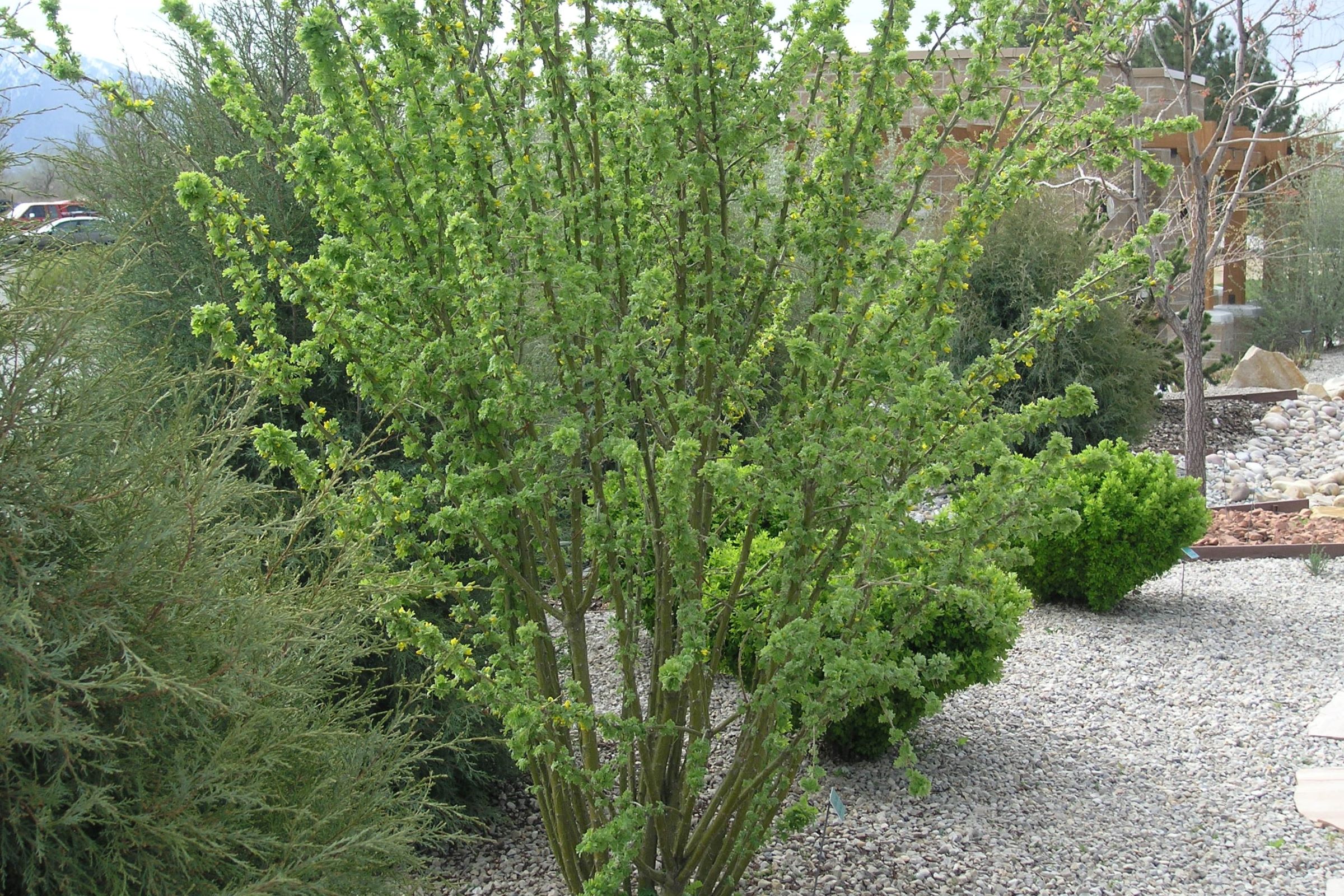
Siberian Peashrub Caragana arborescens
Large thorny upright shrub native to Siberia and Mongolia. Bright green pinnately compound leaves grow on bright green branches. Brilliant yellow pea-like flowers bloom in spring followed by greenish-brown seed pods. Tolerates extreme cold, drought, and poor soils. Siberian Peashrub is known to be invasive in the midwestern US.
-
Siberian Squill Scilla siberica
Early spring flowering bulb with basal, grass-like leaves. The drooping, star-shaped blossoms sit on tall slender stems. The stars are an attractive shade of blue, with a dark blue strip down the middle of each petal. The stamens are white with dark blue tips. It is hardy and highly tolerant of cool temperatures.
-

Sicilian Honey Lily Nectaroscordum siculum ssp. Bulgaricum
A spring blooming bulb that produces dainty, dangling bell-shaped flowers on tall, slender, green stems. The blossoms are a combination of white, pink and purple color. If they get bruised, they will give off an odor similar to onions.
-
Sideoats Grama Bouteloua curtipendula
Clump-forming ornamental grass. Long, slender, gray-green leaves grow basally up to 18" long. Tall spikes of purple, oat-like inflorescences grow in summer and only on one side of the stem. Native to Missouri prairies. Tolerant of a wide range of soil conditions. Grow well in dry soils.
-

Sienna Sunset Coreopsis Coreopsis rosea 'Sienna sunset'
A thread leaf coreopsis that offers burnt sienna colored blossoms that gently fade to a softer orange yellow as they mature. Spreads with rhizomes. Great for edging, border of sidewalks or in naturalized areas. Also good as a container plant.
-
Siloam Little Girl Daylily Hemerocallis 'Siloam Little Girl'
Tall herbaceous perennial with 4" pink summer-blooming flowers with rose eyes. Foliage is long and drooping with grasslike blades about 1 inch wide. Easily grown in a wide range of conditions. As suggested by the name, flowers last one day but are produced over a long period of time. Divide every 3-5 years to maintain vigor.
-

Silver Blade Evening Primrose Oenothera macrocarpa ssp. incana 'Silver Blade'
Similar to the species, this trailing perennial produces large, sunny yellow flowers from late-spring to fall. The leaves of this variety have a silver hue that makes them stand out in the landscape. They can be aggressive spreaders and can be easily cut back if they get too leggy.
-
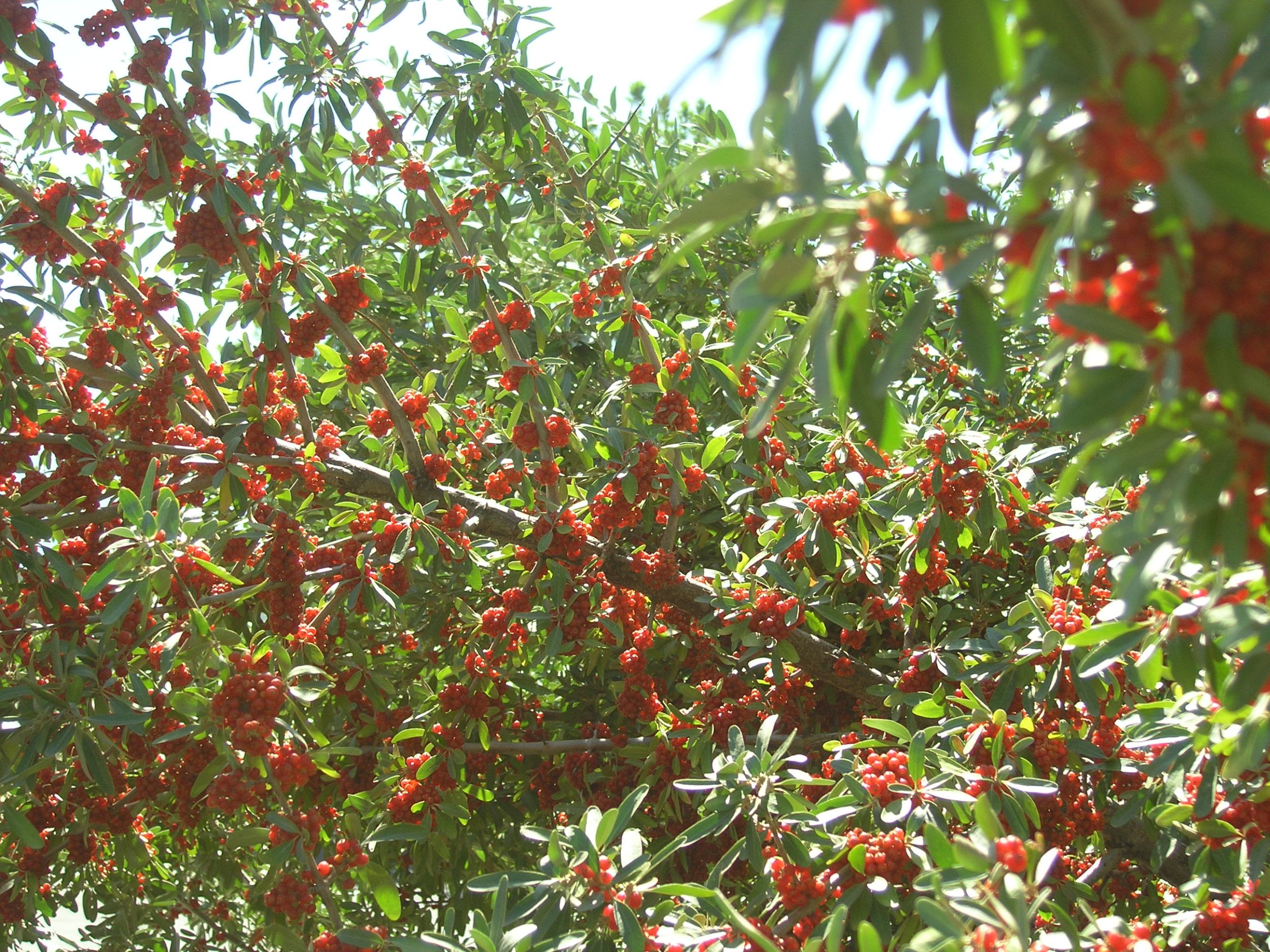
Silver Buffaloberry Shepherdia argentea
Spiny, deciduous, suckering, large shrub or small tree. Closely resembles a small Russian Olive. Oblong gray-green leaves turn brown in autumn. Inconspicuous, but interesting, yellow flowers bloom in early spring. Produces edible red berries. Vigorously growing and difficult to prune. Can be used as a barrier or in naturalized, low-maintenance situations.
-

Silver Butterfly Bush Buddleja alternifolia 'Argentea'
Beautiful medium to large flowering shrub. Can be pruned back to desired height each year, even to the ground if desired. Once established, this plant is tolerant of many conditions. Attracts butterflies and bees. A 1998 Plant Select Winner. This silver-leafed variety has lavendar-purple colored blooms.
-
Silver Carpet Lamb's Ear Stachys byzantina 'Silver Carpet'
Low-growing, semi-evergreen perennial that forms a mat of thick, velvety, silver-gray foliage. Leaf resembles a lamb's ear, hence the name. This cultivar rarely blooms, giving it a tidier appearance. Spreads readily especially in very fertile soils. Semi-evergreen depending on the climate. Tolerant of drought. Susceptible to disease in humid summers. Prefers well drained soils.
-
Silver Edged Horehound Marrubium rotundifolium
Low-growing, vigorous, evergreen perennial. Beautiful gray-green soft felt-y leaves have silver-white edges and undersides. Flowers are insignificant and may be sheared off. Works well as a groundcover or in rock gardens Prefers poor well-drained soils and requires very little water once established. Also referred to as Silverheels Horehound.
-
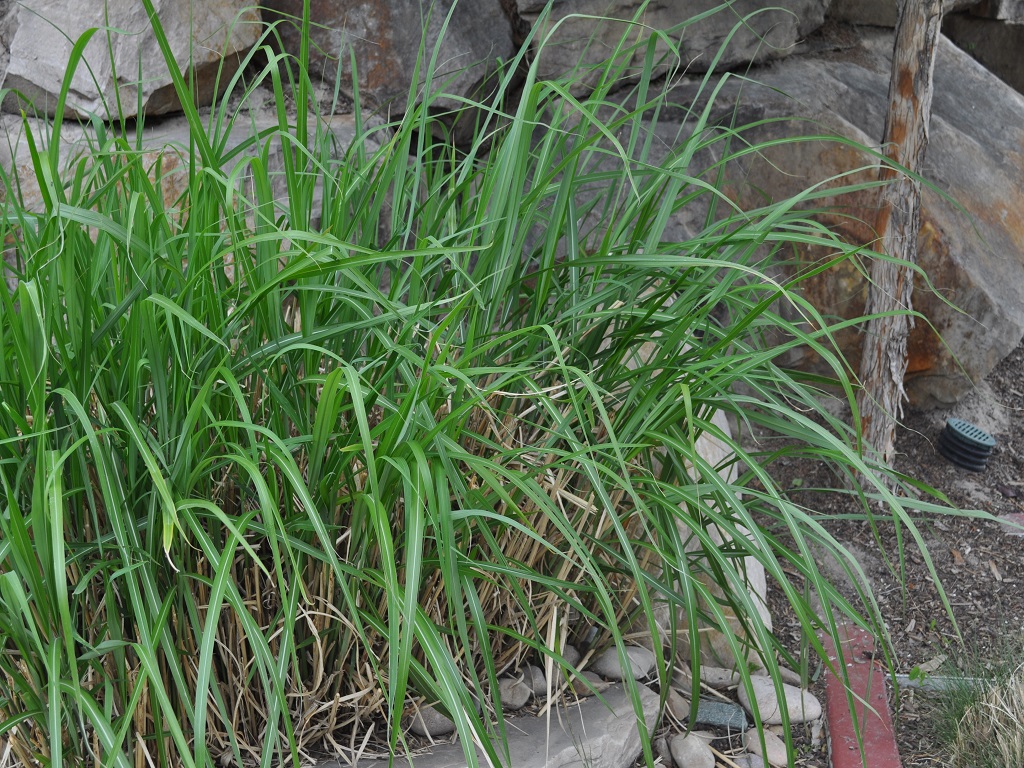
Silver Feather Maiden Grass Miscanthus sinensis 'Silberfeder'
Large clump-forming ornamental grass. Long and slender green leaves contrast nicely with the silvery-white plumes of flowers that appear in late-August. Provides wonderful appeal if left standing through the winter. Cut back in the early spring, before new growth appears.
-

Silver Linden Tilia tomentosa
Large conical deciduous tree with fragrant, creamy yellow flowers that bloom in the summer. Large heart-shaped glossy-green leaves have serrated edges and are silver underneath. Leaves turn muted green to pale-yellow in the autumn before falling. Branches grow densely upright and may need some pruning to promote healthy structure. Tolerant of alkaline soils and grows best with moderate water.
-
Silver Mist Himalayan Cedar Cedrus deodara 'Silver Mist'
Densely packed, conical evergreen prized for its flushes of snowy white, new growth. As ‘Silver Mist’ matures a terminal leader may emerge, but the general shape will stay compact when compared to others of its kind, making it great for smaller spaces.
-

Silver Moon Clematis Clematis 'Silver Moon'
Compact early-flowering climbing vine. Silver-grey to lavendar 4-6" blossoms appear in late spring. Group 2 type clematis. Very little pruning required as blooms appear on second year's growth. Will tolerate some shade.
-
Silver Sage Salvia argentea
This biennial boasts large fuzzy silver leaves that are soft to the touch and provide beautiful textural contrast in the garden. The leaves have wavy margins and grow in a rosette shape. Flower spikes emerge in the summer of its second year, developing into dramatic 3-foot candelabras topped with small white flowers.
-
Silverberry Elaeagnus commutata
Large, upright, deciduous shrub native to Utah and much of the western United States. Silver-grey leaves are lanceolate. Small yellow flowers bloom in late-spring to early-summer and turn to pulpy, silver-grey fruits.
-
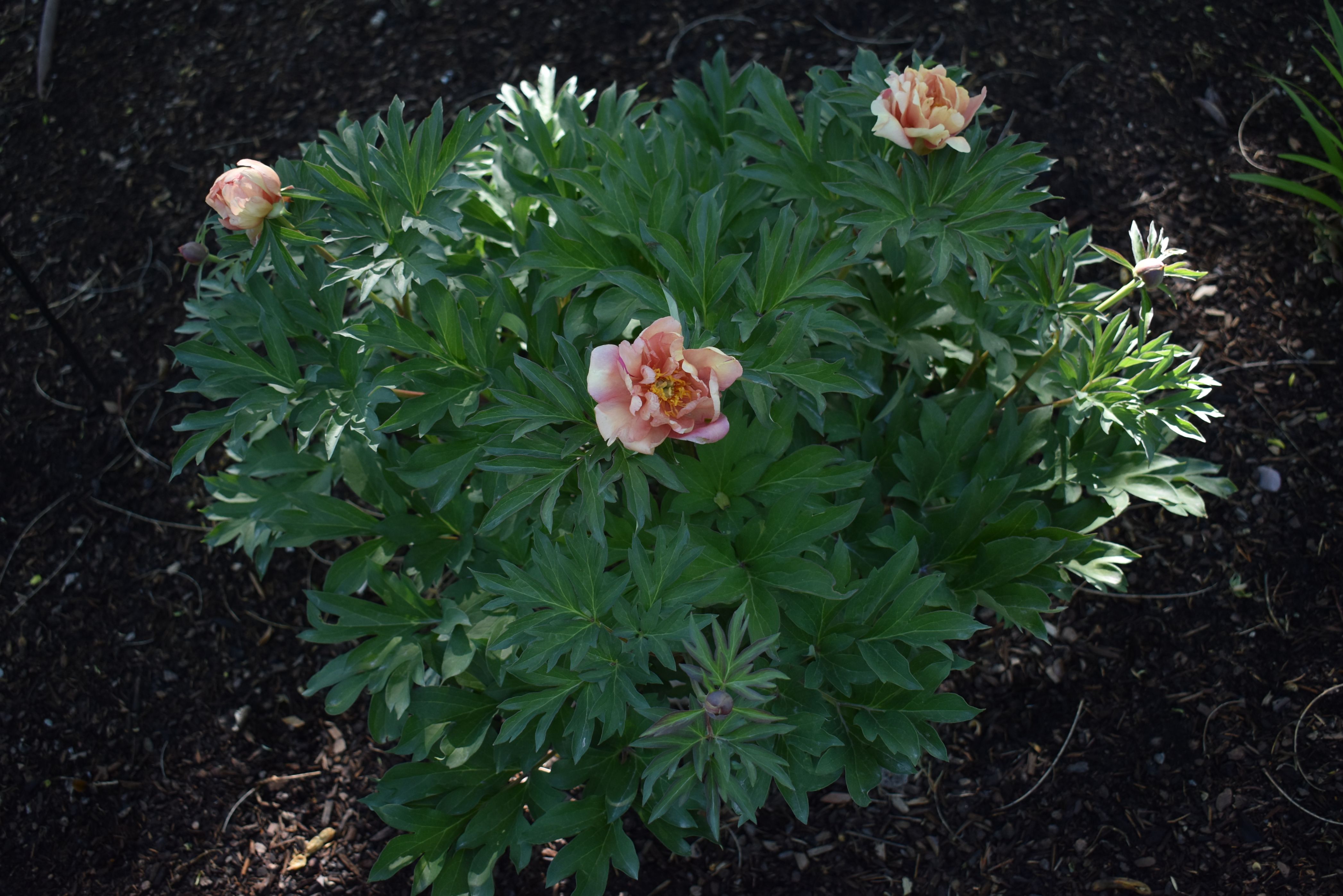
Singing in the Rain Itoh Peony Paeonia 'Singing in the Rain'
Large, semi-double, creamy yellow peony blossoms come in late spring and as they mature into the early summer, they take on peachy-coral shades. On top of being beautiful and showy, these blossoms add a soft fragrance to the area. This shrubby perennial is sure to add splashes of color and sweet aromas along borders and in focal areas. Itoh peonies, or intersectional peonies, are hybrids of the tree peony (P. lemoinei) and garden peony (P. lactiflora).
-
Single Apricot Chrysanthemum Chrysanthemum 'Single Apricot'
A compact, mounded perennial, this chrysanthemum is at its most beautiful just before frost. Profuse daisy-like blooms appear in October and glow with rays in a soft apricot hue with yellow centers. It prefers plenty of moisture and organic soils but will tolerate and bloom in less than optimal conditions. The leaves are dark green and lobed with a distinct aroma when touched.
-

Singleleaf Ash Fraxinus anomala
A small tree native to Utah and the southwestern United States. Single, mid-green leaves are ovate and slightly serrated on the edges. In autumn the leaves turn a bright yellow before falling. It is the only member of the genus that does not have compound leaves. Inconspicuous white flowers turn to elongated seed pods in summer. This tough tree can handle poor soils and dry conditions once established.
-
Singleleaf Pinyon Pinus monophylla
This tough pine tree is native to the southwestern United States including Utah. It is very slow-growing and will take decades to reach it's maximum 15 feet in height. Bluish-gray needles are its best characteristic, making it a natural look for desert landscapes. It grows well in alkaline soils but prefers well-drained sites.
-
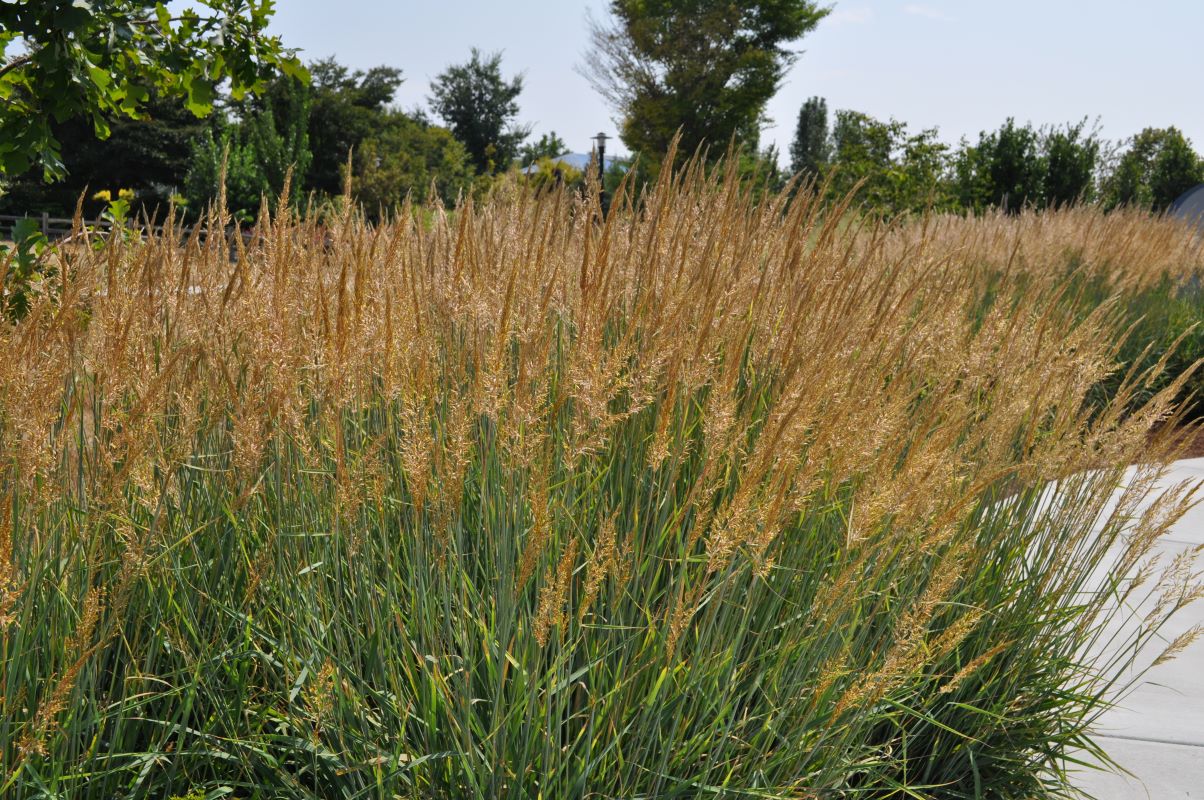
Sioux Blue Indian Grass Sorghastrum nutans 'Sioux Blue'
Upright growing, clump-forming ornamental grass. Powder-blue leaves grow about 1/2" wide turning yellow to gold in the fall. Tan inflorescenses appear in mid to late-summer and grow on thin stalks above the plant. Tolerant of drought and poor soils. Fertile soils may cause the plant to flop and aggresively reseed. The species is native from Utah to the east coast.
-

Six Hills Giant Catmint Nepeta 'Six Hills Giant'
This tall catmint is also one of the hardiest varieties. It also has one of the longest bloom times of all catmints. It is broad, vigorous, and free flowering in a deep violet-blue blossoms. This plant likes dry, poor soils. Cut back to the ground after first blooms fade to encourage a second bloom.
-
Skandia Juniper Juniperus sabina 'Skandia'
Low-growing, spreading evergreen shrub. Low, arching branches are densely layered and compact with gray-green to green linear foliage. Requires full sun and very little water once established. Resistant to juniper blight. Tolerates alkaline and infertile soils. Very low maintenance.
-

Sky Blue Aster Aster azureus
An easy-going showy perennial that goes all-out in fall with masses of light purple-blue flowers. The small daisy-shaped flowers have delicate petals and yellow to brown centers, while the leaves transition from thin at the top of the plant to heart-shaped at the bottom. Grows well in a variety of soil and sun conditions.
-

Sky Trails Serbian Spruce Picea omorika 'Sky Trails'
Narrow, pyramidal evergreen conifer. Serbian spruce is one of the best spruces for the landscape due to its tolerance of urban conditions. Deep green to blue-green needles have silvery colored stripes; providing a pleasing contrast. Graceful branches grow all the way to the ground. Sky Trails has a tall, upright, weeping habit and resembles Douglas fir. Bark is reddish-brown. Cones are roughly egg-shaped. Prefers moist, fertile soils but is tolerant of other conditions.
-
Skyline Honeylocust Gleditsia triacanthos f. inermis 'Skyline'
A medium-sized shade tree with an excellent pyramid shape, a strong main trunk, and evenly spaced, gently swooping branches. Although the species has thorns and large pods, this variety is thornless and typically won't produce pods. The leaves are fernlike and composed of numerous leaflets, creating light dappled shade and making fall clean-up easy. The green rounded leaflets have serrated edges and will turn yellow in autumn. Flowers are yellow and insignificant. Very tolerant of dry and compacted soils as well as periods of drought and excess moisture.
-
Skyrocket Juniper Juniperus scopulorum 'Skyrocket'
Columnar, upright-growing evergreen tree or tall shrub. Scale-like leaves vary in color from grey-green to blue-green. Branches grow upward creating a dense, columnar tree perfect for formal landscapes and areas needing wind and privacy screens. The spread can vary within this cultivar. Requires little maintenance and retains its shape quite well. Prefers drier soils, avoid overwatering. It works well in formal settings.
-
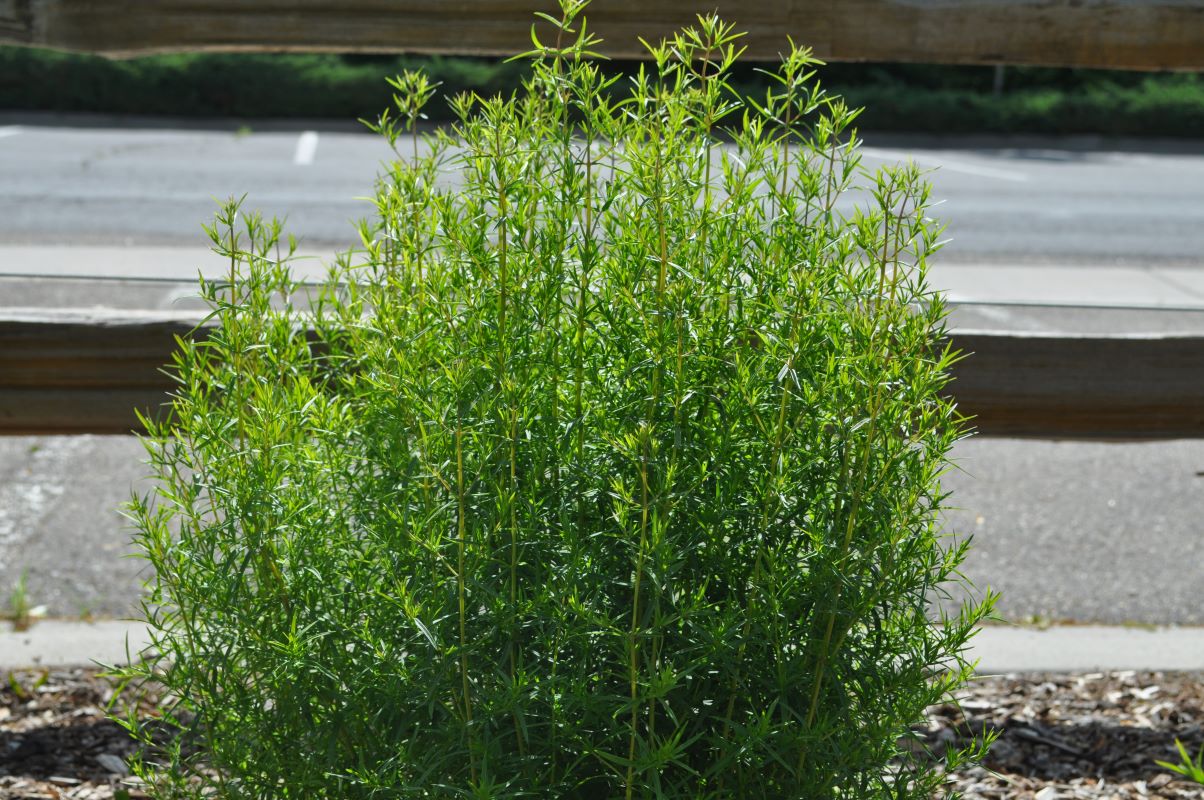
Slenderleaf Mountain Mint Pycnanthemum tenuifolium
This herbaceous perennial offers clusters of vivid white blossoms that bloom throughout the summer. The foliage is highly narrow and almost needle-like. Mountain mint also provides fragrance and culinary benefits. When crushed, all parts of the plant give off a minty aroma and the leaves have been used in teas.
-
Slowmound Mugo Pine Pinus mugo 'Slowmound'
Very slow-growing compact variety of mugo pine. Short dark green needles are very attractive and provide a uniform appearance. Forms a dense mound that will not outgrow the landscape. Requires very little pruning. Provide well drained soils. Will tolerate some drought once established.
-

Small Woodland Sunflower Helianthus microcephalus
This perennial wildflower has green, spear-head shaped leaves. Midsummer brings an abundance of dainty, bright yellow, daisy-like blossoms. Plant Small Woodland Sunflower in mass groupings to give the landscape a large flush of color.
-
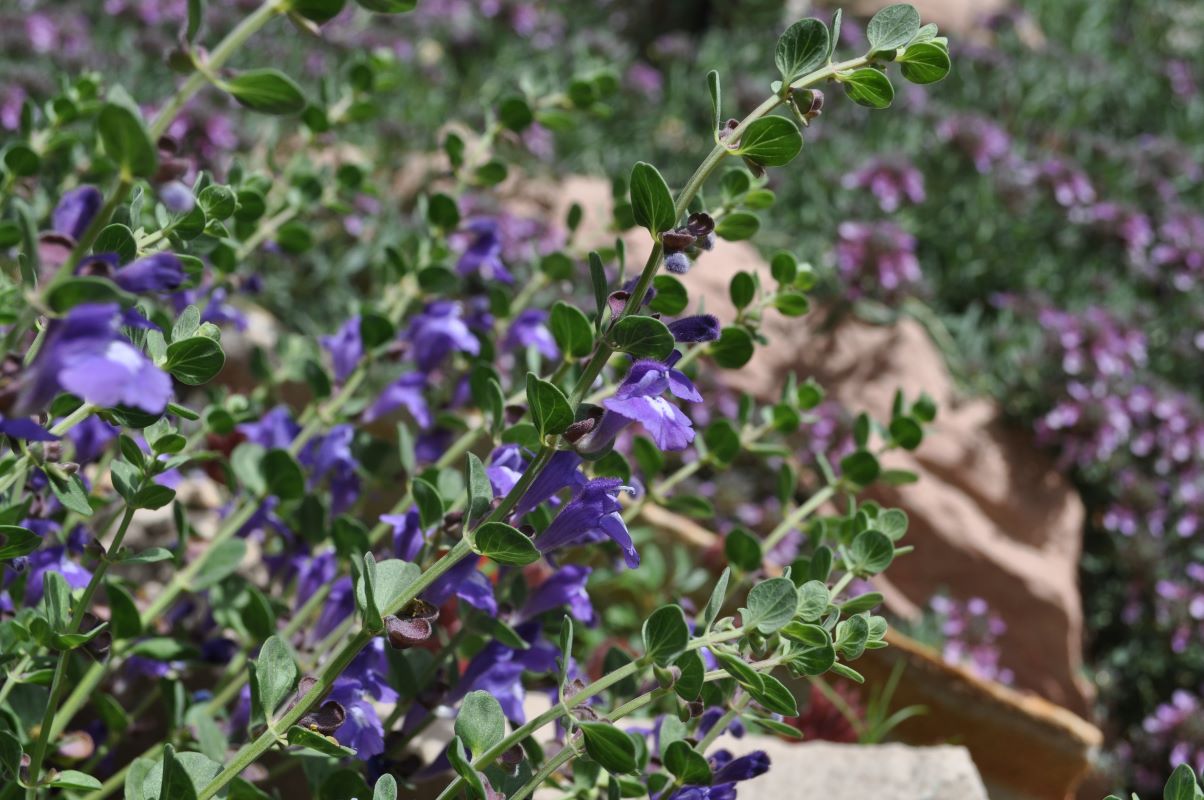
Smoky Hills Skullcap Scutellaria resinosa 'Smoky Hills'
A woody based perennial with branching, upright stems. It has rounded leaves that are gray-green in color. The tubular, lavender-blue flowers have two white stripes. It blooms for most of the summer and is a great addition to a hot, sunny rock garden. This plant is a member of the mint family but doesn’t have much fragrance. It prefers well-drained soils and is okay with rocky growing areas.
-

Smooth Sumac Rhus glabra
This large thicket-forming shrub can spread aggressively and take over large areas if left unchecked. Large compound leaves are made up of lance-shaped leaflets. Fall changes the leaves from green to bright shades of orange and red. Inconspicuous flowers turn into large cone-shaped clusters of dark red, fuzzy fruit. Tolerant of a wide range of soils except overly wet ones.
-
Snow Day Surprise Pearl Bush Exochorda 'Niagara'
White flowers cover this shrub like snow throughout spring. This is a hardier selection than the standard pearl bush and has a neater, more rounded and compact habit. The oval-shaped deciduous leaves turn yellow in fall.
-

Snow Flurry Aster Aster ericoides 'Snow Flurry'
The leaves of this groundcover perennial are heath-like. It forms a dense mat of foliage that produces abundant white flowers with yellow centers. It is very drought tolerant and prefers full sun, but will tolerate light shade. It's attractive to butterflies and other pollinators when in bloom. Also known as Symphyotrichum ericoides 'Snow Flurry'.
-
Snow Queen Phlox Phlox 'Snow Queen'
Snow Queen Phlox forms a tidy, dense mound of dark green, narrow, needle-like foliage. The spring brings an abundance of dainty, pure white blossoms that sit on top of the leaves. This phlox enjoys being in sunny rock gardens, along walkways or in pots.
-

Snow White Mock Orange Philadelphus 'Snow White Fantasy'
Multi-stemmed deciduous shrub with upright arching brances. Profuse white flowers are double and very fragrant. Blooms begin in late spring and last up to 4 weeks. Tolerates some shade but produces more flowers in full sun. Requires low to moderate amounts of water. Adaptable to many soil types.
-

Snow-in-Summer Cerastium tomentosum
Rampant, mat forming perennial producing white or silvery woolly leaves. Profuse amounts of star shaped five petalled 1" white flowers bloom in late spring to summer. Tolerates a wide range of soils as long as they are well-drained. Great for ground covers or rock gardens. Prefers full sun.
-

Snowball Viburnum Viburnum opulus 'Roseum'
Also known as European Cranberrybush, this bushy, round shrub is eye-catching in more than one season. Late spring brings large round clusters of flowers resembling snowballs that change from soft green to white to pale pink, making for great cut flowers. In the fall, maple-shaped leaves turn striking shades of orange and red. This is a sterile cultivar with no berries.
-

Snowberry Symphoricarpos albus
Upright, arching, thicket-forming shrub. Mid-green, oval leaves usually have smooth edges but can be somewhat lobed. Pinkish-white, bell-shaped flowers bloom in the summer. Forms clusters of rounded pure-white berries. Though not toxic, the berries are best left on the bush. Plant in well-drained soils. Performs well as an understory plant.
-
Snowcap Shasta Daisy Leucanthemum x superbum 'Snowcap'
Dwarf clump-forming perennial with dark green, lance-shaped foliage. Large, solitary, white flowers with yellow centers bloom in early to late summer. Prefers well-drained, moist soils. Tolerates some drought. Very showy, suitable for most landscape situations.
-

Snowdrop Galanthus nivalis
One of the earliest spring blooming flowers, often blooming when snow is still on the ground. Nodding, white, bell-shaped flowers bloom above slender grass-like leaves.
-

Snowflake Oakleaf Hydrangea Hydrangea quercifolia 'Snowflake'
Large, snowy-white clusters of flowers adorn this hydrangea throughout the summer. This species is better able to tolerate alkaline soils than some of its cousins. Its deeply lobed leaves resemble those of an oak. Will handle some shade but it needs plenty of water for it to thrive.
-

Snowhill Meadow Sage Salvia x sylvestris 'Snow Hill'
Compact herbaceous perennial with spikes of snow white flowers that bloom profusely in June and continue sporadically through the summer. Green leaves with serrated edges are quite large at the base with smaller leaves growing from the stems. Remove spent blossoms to promote additional blooming.
-

Snowmound Spirea Spiraea nipponica 'Snowmound'
Compact, mounding deciduous shrub. Green ovate leaves grow on arching stems. Pure white flowers grow in abundant clusters in mid to late-spring. Vigorous growing, may spread. Tolerates a wide range of soils but prefers moderate amounts of water.
-

Soapwort Saponaria ocymoides
A low-growing semi-evergreen groundcover, soapwort makes a carpet of pink flowers over green foliage. It is very vigorous and will spread both by rhizomes and seeds, so put it in a place that it has room to stretch. It makes a good filler for crevices in rock walls and grows well in colder climates. Shearing the flowers as they fade will keep them from reseeding.
-
Sol Dancer Daisy Tetraneuris (syn Hymenoxis) acaulis var. arizonica 'Sol Dancer'
Cheerful and everblooming, Sol Dancer Daisy handles heat, drought and poor soils. Large, bright yellow blooms on sturdy stems appear in late spring and continue until frost. Foliage is grass-like, uniform and deer resistant. Sol Dancer prefers good drainage and appreciates a gravel mulch that encourages re-seeding. In order to encourage re-seeding, do not deadhead all spent blooms. Needs little water once established. A Utah State University Sego Supreme introduction. Also known as Four-nerve daisy.
-

Solitary Clematis Clematis integrifolia
Summer blooming herbaceous perennial with 2" blue flowers. Forms a gradually expanding clump of stems arising from the center. Each stem is topped with one flower. Group 3 type clematis. Cut back to 2" from the center every year.
-
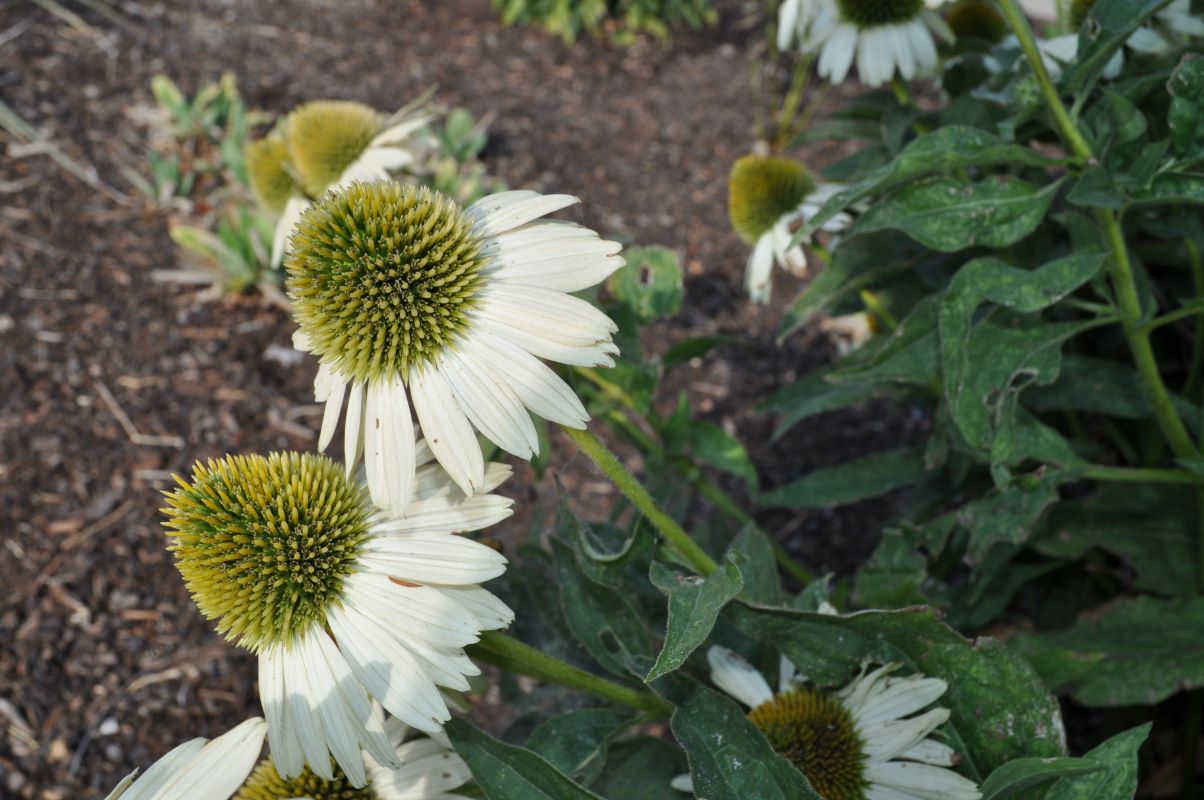
Sombrero Blanco Coneflower Echinacea purpurea 'Balsomblanc'
This perennial has compact mounds of green foliage. It features bright white flowers with an exceptionally long bloom season. It is a great low maintenance choice for a summer, sunny border or a cutting garden. Cold hardy and drought tolerant once established.
-
Sombrero Flamenco Orange Coneflower Echinacea x hybrida 'Balsomenco'
This sturdy and compact coneflower offers an abundance of large, single flowers with vibrant orange-red petals surrounding a brown cone center. The blooming period starts midsummer and continues through early fall. As the seed heads dry, they can be left up for hungry birds or to add winter interest.
-

Song Siren Laura Yarrow Achillea millefolium 'Laura'
Hardy perennial with ferny foliage and flat-topped flower clusters. Long-blooming ruby-red flowers with white centers open in early-summer and last until fall. Gray-green aromatic leaves are unappetizing to deer. Flowers may be used as decorations when dried. Tolerates many soil types and low amounts of water. Clumps will spread, but not uncontrollably.
-
Sonoran Sunset Hyssop Agastache cana 'Sinning'
A native of New Mexico, this hyssop features tubular, sweetly fragrant, purple flowers arranged in whorls on salvia-like spikes. Has a long bloom time from June to September. Prefers full sun and low moisture. Non-invasive. Atractive to butterflies and bees.
-

Sorbet Peony Paeonia lactiflora 'Sorbet'
Sorbet Peony displays glossy green leaves that show off the luscious blossoms beautifully. In late spring bright pink buds form which mature into blush-pink and creamy white double blossoms. They are lightly fragrant and great as a cut flower. The foliage turns red in the fall.
-

South Seas Daylily Hemerocallis 'South Seas'
The flowers of this daylily vary from mango to scarlet in late-spring through summer. Its leaves are long and linear and grow from the base of the plant. It is hardy and can handle Utah's climate but needs consistent water.
-
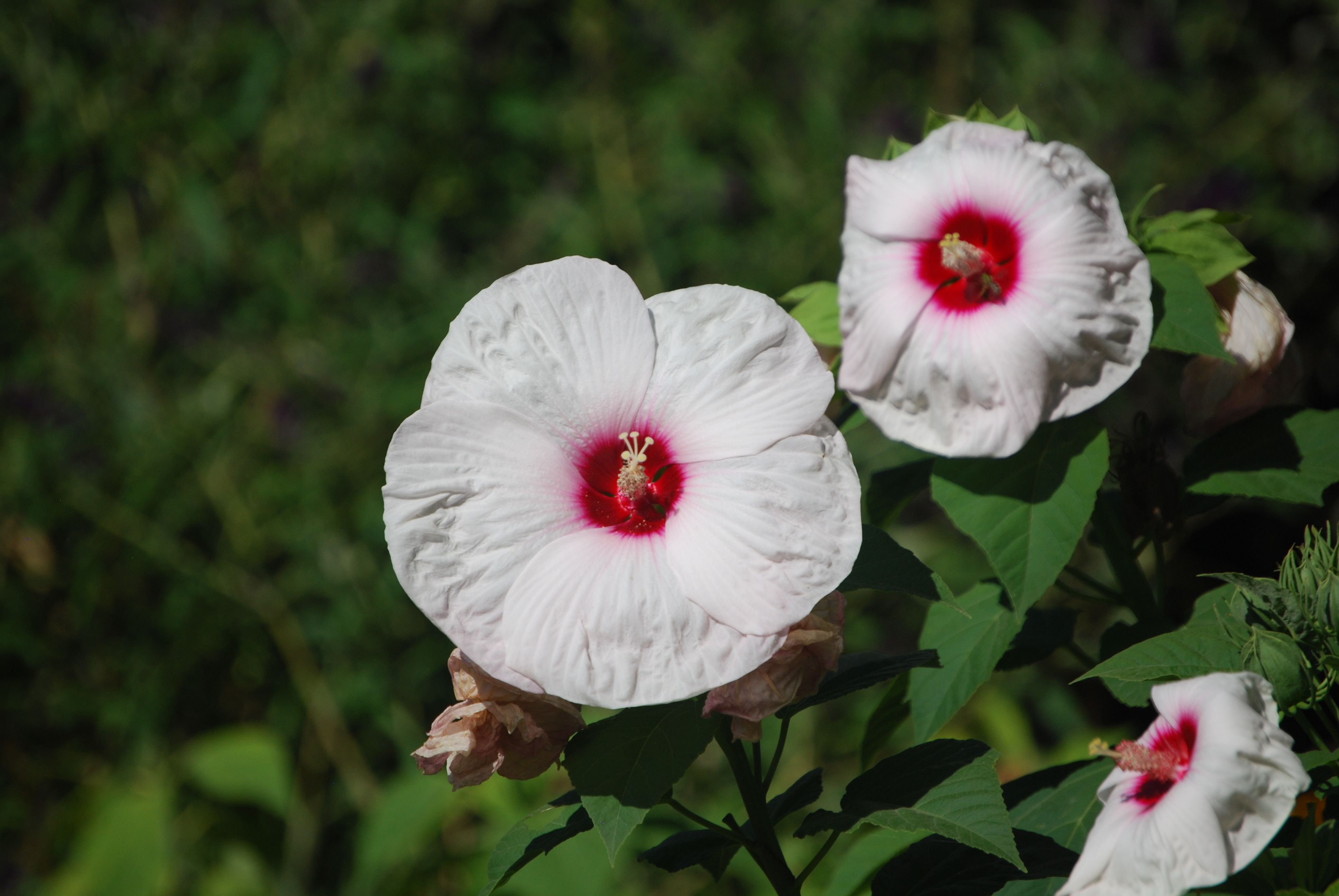
Southern Belle Hardy Hibiscus Hibiscus moscheutos Southern Belle Group
Vigorous compact herbaceous perennial. Large white flowers grow up to 10 inches in diameter with a dark red eye. Blooms open during the summer months and last for one day with multiple blooms opening each day. Large dark green serrated leaves complete this lovely perennial creating a beautiful plant. Tolerates heat and will adjust to different soils but prefers fertile organic soils. Needs evenly moist soil.
-

Southern Charm Mullein Verbascum 'Southern Charm'
This showy perennial is characterized by blush pink flowers with dark purple centers that grow on tall stems. The leaves grow basally and are large and deeply veined. It will bloom repeatedly through the summer if located in the right spot. If flowers are not deadheaded it will self seed.
-
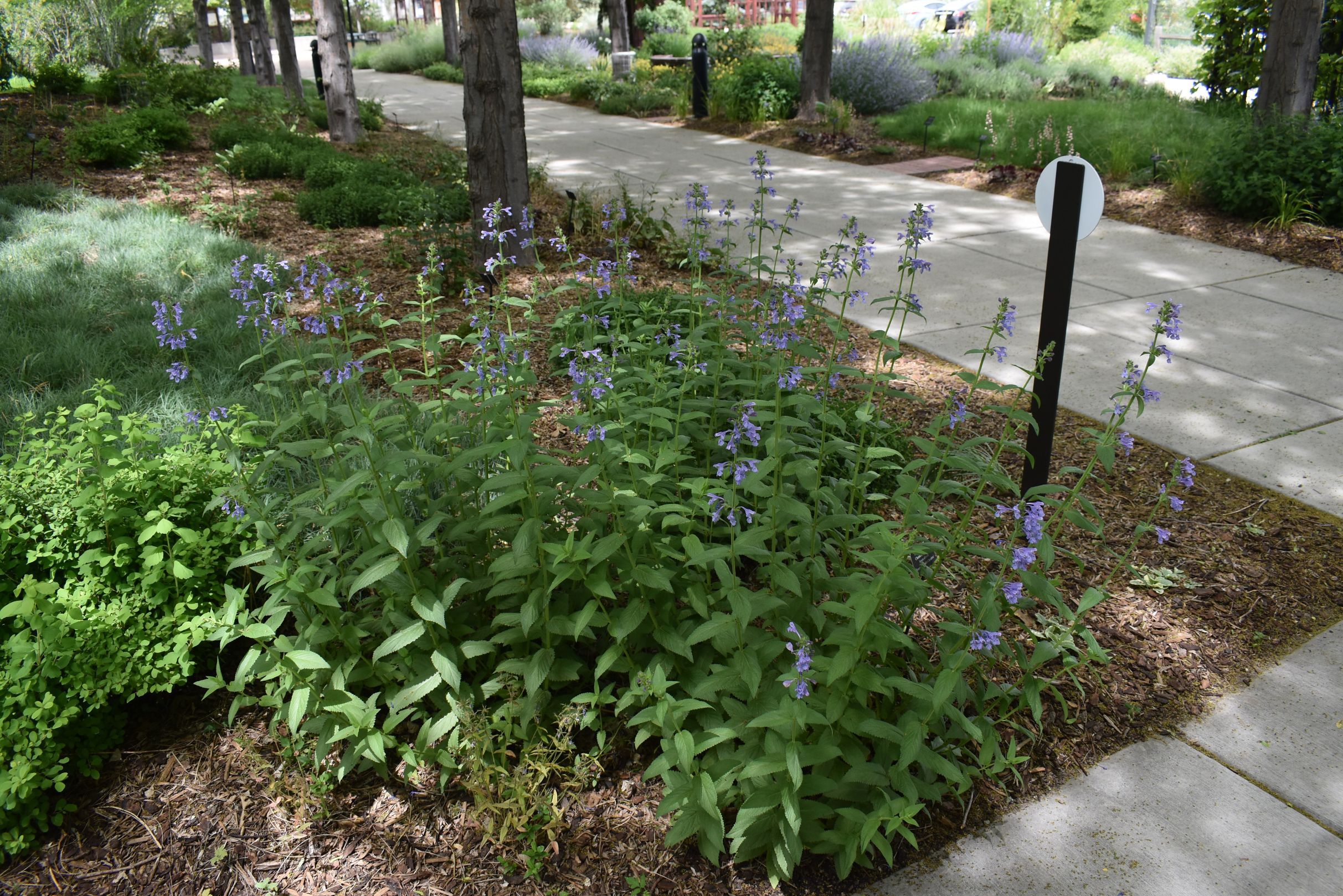
Souvenir d' Andre Chaudron Catmint Nepeta sibirica 'Souvenir d' André Chaudron'
This unusually tall and cold-hardy catmint grows in clumps of tall upright stems. The spikes of lavender-blue flowers bloom in late spring through early summer. The lance shaped leaves of this catnip relative are aromatic, and may have some small attraction for cats. This member of the mint family is native to Siberia, hence the botanical name. Tolerates dry soils but will not grow well in wet soils. In moist areas it may become somewhat invasive.
-
Spaan's Dwarf Shore Pine Pinus contorta 'Spaan's Dwarf'
A globose, dwarf shore pine featuring irregular branches with petite, dark green needles. The unique branching creates an open habit with beautiful negative space within the shrub. This evergreen will add character and interest year-round.
-
Sparkler Colorado Blue Spruce Picea pungens var. glauca 'MonWal'
This cultivar of the Colorado spruce is densely pyramidal. It is stunning yellow-gold as new growth and matures to blue-green foliage. The slower growing habit of this evergreen makes it perfect for an accent, windbreak or tall screen. Evergreen.
-
Spearmint Juniper Juniperus chinensis 'Spearmint'
A cultivar of Chinese juniper, 'Spearmint' grows in an upright columnar form, rarely reaching more than 4 feet in diameter. It had bright-green scale-like foliage that is attractive throughout the year. It is tolerant of many soil types and drought, once established. It does not do well in wet soils.
-

Spotted Dead Nettle Lamium maculatum 'Beacon Silver'
Herbaceous perennial with very attractive silver grey foliage color. Dramatic contrast with the masses of small, tubular orchid pink flowers in whorl. This plant is attractive to bees, butterflies and birds.
-

Spotted Geranium Geranium maculatum
Bushy erect perennial native to eastern North America. 5-petaled pink to lilac flowers appear in spring and usually do not rebloom. Mid-green leaves are deeply lobed and may turn yellow during drought and extreme heat. Prefers moist fertile soils but will adapt to drought and poor soils.
-

Spreading Cotoneaster Cotoneaster divaricatus
Long arching branches covered with 1" elliptical glossy green leaves are a hallmark of this large cotoneaster. Abundant white-pink flowers bloom in the spring, giving way to large bright red fruit. Fall turns the leaves shades of red and orange. It may be evergreen during mild winters. It is very tolerant of poor soils and can handle drought once it has established.
-

Spring Flurry Serviceberry Amelanchier laevis 'Spring Flurry'
A reliable low maintenance tree with white showy flower in the spring and bright orange leaf color in fall. Main branch is upright and overall shape is oval. Produce blue berries in late spring. Ripe berries taste like a mixture of blueberry, apple and sweet cherries. Plants grow in moist to well drained dry soil.
-

Spring Glory Forsythia Forsythia x intermedia 'Spring Glory'
Rounded deciduous flowering shrub. Abundant soft yellow flowers are produced in early spring. Mid-green foliage and arching stems make it a perfect backdrop. Full sun produces better flowering, but it will tolerate part shade. Great as a screen or to cover hills and slopes.
-

Spring Snow Crabapple Malus 'Spring Snow'
Nice mid-sized flowering ornamental tree with a dense oval shape. Abundant, fragrant white flowers bloom in spring. Best in full sun. Good disease resistance. Rarely produces fruit which makes it a good choice for patios or areas where fruit drop would be detrimental.
-

St .John's Wort Hypericum calycinum
Dwarf, spreading, evergreen shrubby perennial with bright yellow, 5-petaled, flowers with reddish anthers that bloom through out the summer. Dark green oval-shaped leaves make an attractive groundcover. Prefers evenly moist soils but tolerates some drought and a wide range of soil types.
-

St Mary's Sun Rose Helianthemum 'St. Mary's'
Low-growing, evergreen, shrubby perennial. Small, green, lance-shaped leaves are downy. Bears profuse pure white rose-shaped flowers in late-spring to early-summer. Grows well as a groundcover or in rock gardens. Presents a very stunning show when covered with flowers.
-

St Theresa Grape Vitis 'St. Theresa'
An introduction from the Plant Select Program, this seedless grape is cold hardy and tolerant of alkaline soils. The fruit matures early and is purple with a slip skin. The leaves are green and lobed. It makes a good vine for ornamental purposes, but should be pruned properly in order to ensure the maximum fruit.
-

Stainless Steel Coral Bells Heuchera 'Stainless Steel'
This outstanding cultivar of a classic clump-forming perennial has striking silver-gray foliage with purple undersides, as well as an impressive display of creamy-white flowers on tall stems in late spring. Will burn and discolor if planted in full sun, or if it experiences too much drought and heat. Can be evergreen during mild winters. Prefers fertile, moderately moist soils.
-

Standing Ovation Serviceberry Amelanchier alnifolia 'Obelisk'
This deciduous shrub grows in an oval column with circular, green leaves that turn shades of gold and orange in the fall. Spring brings clouds of delicate white flowers. In June, edible purple-black berries resembling blueberries are loved by birds.
-

Stark Crimson Spire Apple Malus pumila 'Obelisk'
Small apple tree bearing crimson red fruit with sweet-tart flavor. Great tree for producing fruit in limited spaces. Available through Stark Bros. nursery. Does not self pollinate. In order to bear fruit, it must have another apple tree nearby.
-

Stark Emerald Spire Apple Malus pumila 'Tuscan'
Small apple tree bearing orange-blushed green fruit with sweet-tart flavor. Great tree for producing fruit in limited spaces. Available through Stark Bros. nursery. Does not self pollinate. In order to bear fruit, it must have another apple tree nearby.
-
Stella de Oro Daylily Hemerocallis 'Stella de Oro'
Tall herbaceous perennial with bright yellow summer-blooming flowers on tall talks. This cultivar is one of the most popular. Foliage is long and drooping with grasslike blades about 1 inch wide. Easily grown in a wide range of conditions. As suggested by the name, flowers last one day but are produced over a long period of time. Divide every 3-5 years to maintain vigor.
-

STEPPESUNS Sunset Glow Penstemon Penstemon pinifolius 'P019S'
This Penstemon has a natural mounding form and glossy green leaves that resemble pine needles. The warm orange blossoms bloom throughout the summer. This perennial will beautifully compliment plants that have shades of blue, pink and silver. Native to New Mexico.
-
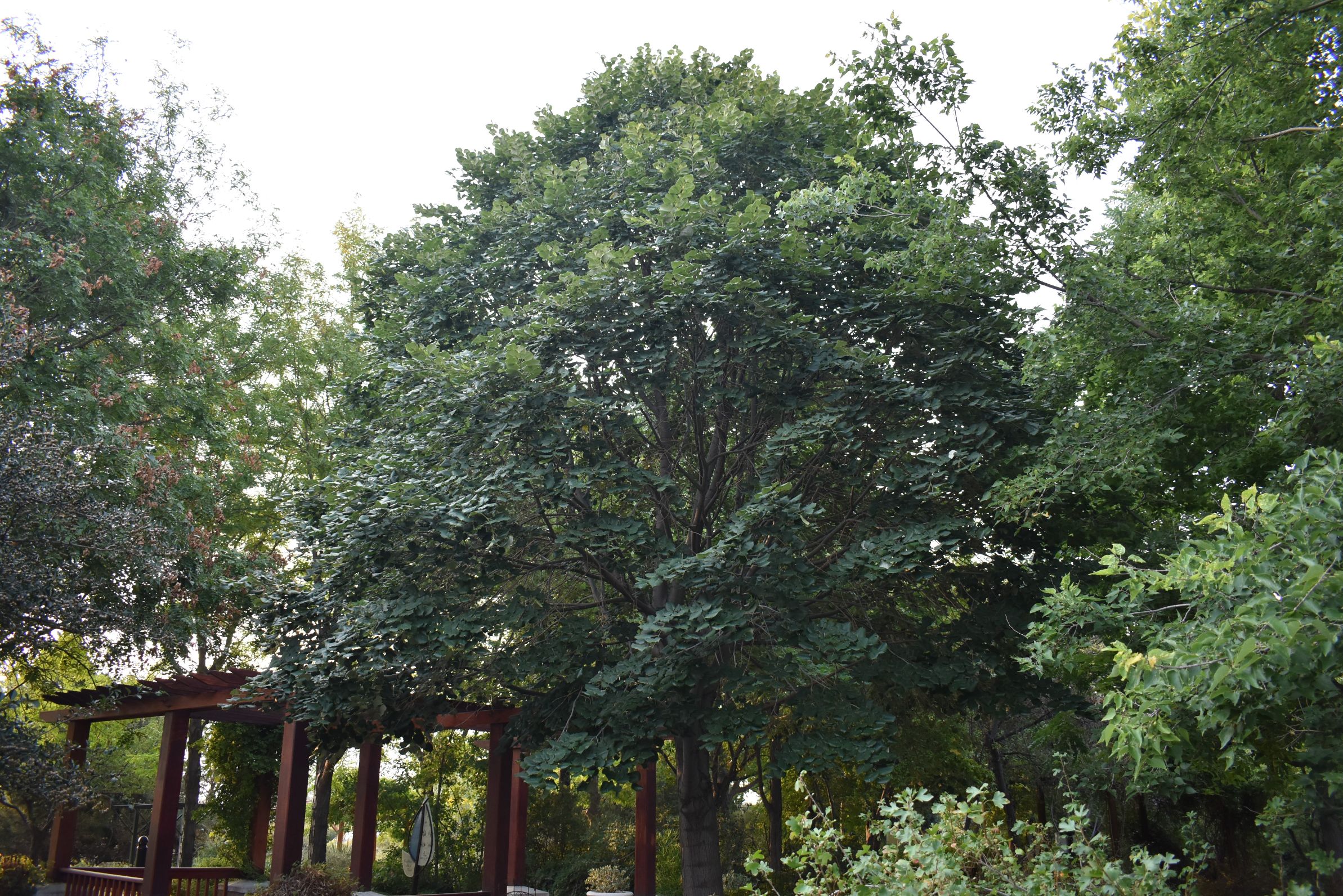
Sterling Silver Linden Tilia tomentosa 'Sterling'
Medium to large deciduous tree with a broadly pyramidal form. Dark green leaves are strikingly silver and fuzzy underneath causing the tree to appear to shimmer in the breeze. Fragrant summer blooming flowers are yellow. This cultivar is resistand to Japanese Beetle and Gypsy Moth. Tolerant of drought but leaves may burn if too extreme. Tolerates many different soil types and conditions.
-

Sticky Jerusalem Sage Phlomis russeliana
Easily-grown erect perennial. Mounds of fuzzy, heart-shaped green leaves make a great grouncover and prevent the growth of weeds. Pale-yellow hooded flowers appear in clusters mainly during early-summer. May flop in too much shade. Prefers well-drained soils and warm conditions.
-

Sticky Purple Geranium Geranium viscosissimum
Found in open woods and meadows this tall wildflower has large deeply cleft, maple-like leaves and five petaled pinkish-purple flowers w/purple veins that bloom in summer, occuring in loose groups at the top of the plant. Stems have tiny glands that secret a sticky substance, thus the name. Prefers full sun to light shade and moister soils.
-

STRAIGHT TALK Privet Ligustrum vulgare 'Swift'
This densely branched, upright shrub is perfect for tighter spaces. It has glossy, oval, dark green foliage that can be enjoyed all season long. Straight Talk produces softly scented white flowers from late spring to early summer and black berries in the fall.
-

Strawberry Candy Daylily Hemerocallis 'Strawberry Candy'
Tall herbaceous perennial with pink summer-blooming flowers with rose-pink eye and yellow-green center. Foliage is long and drooping with grasslike blades about 1 inch wide. Easily grown in a wide range of conditions. As suggested by the name, flowers last one day but are produced over a long period of time. Divide every 3-5 years to maintain vigor.
-
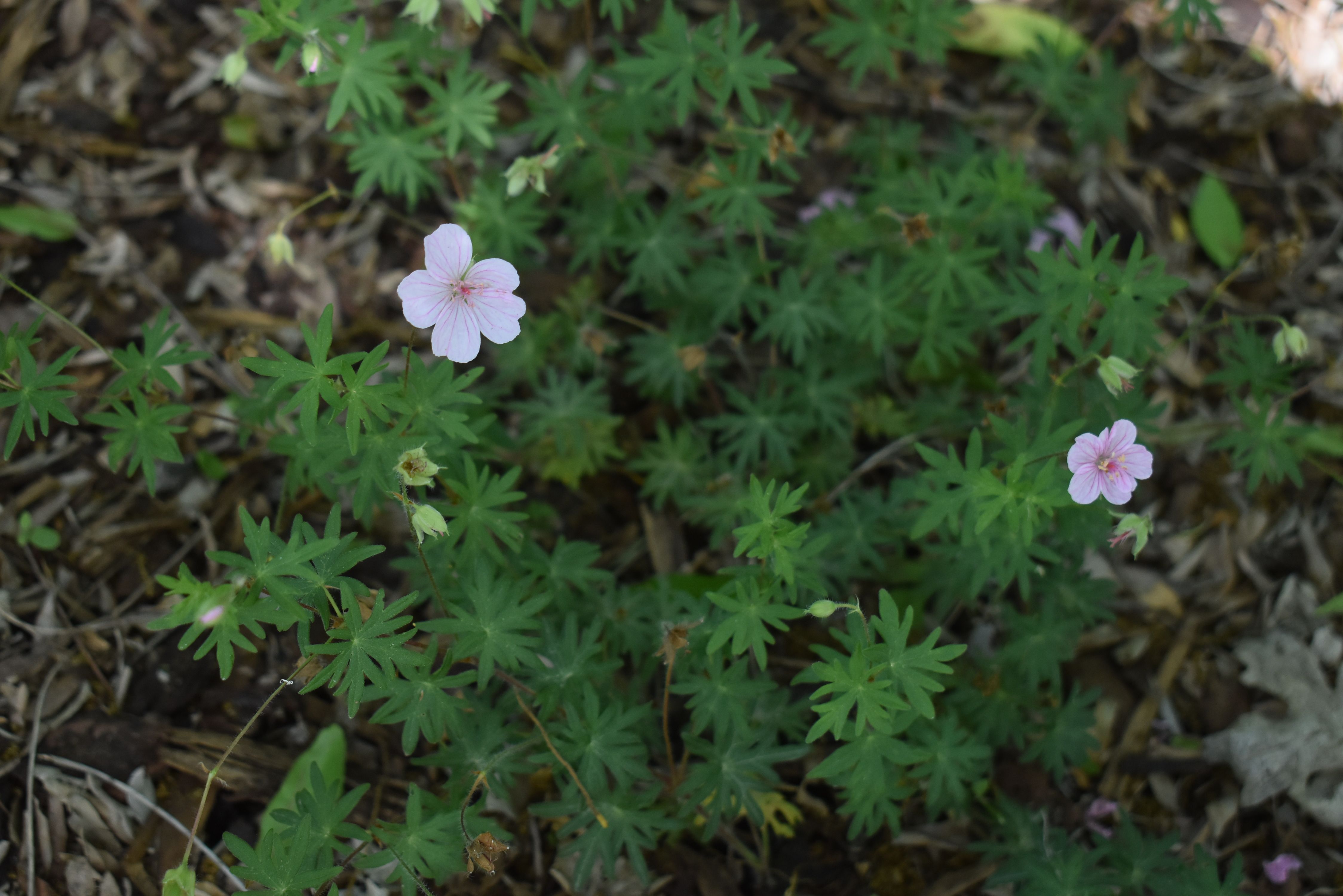
Striped Cranesbill Geranium sanguineum var. striatum
Low-growing, compact, clump-forming perennial also known as Bloody Cranesbill. Dark green leaves are deeply toothed and smaller than other geraniums. Light-pink flowers with darker pink veins mainly bloom in spring but reappear to a lesser degree throughout the year. Will tolerate some drought. Prune to keep it to a desirable size.
-

Sugar and Spice Foamflower Tiarella 'Sugar and Spice'
This herbaceous perennial does well in highly shaded areas. The foliage alone adds interest and beauty to the landscape with its lacey shape, shiny green color and dark crimson markings in the center. In addition, rose-pink buds open into dainty, airy bottle-brush blossoms that rise high above the leaves in late spring to early summer.
-
Sulfur-Flower Buckwheat Eriogonum umbellatum
Spreading, mat-forming perennial that produces cream to sulfur-yellow ball-like clusters of flowers that become copper-red tinted with age. Begins flowering in early summer and continues until the fall. The glossy evergreen leaves turn burgundy and remain attractive through the winter. Prefers moderate to dry well-drained soil. Do not overwater.
-

Sultan's Palace Iris Iris 'Sultan's Palace'
Upright growing perennial with fragrant flowers. Large dusty maroon flowers bloom in spring. Attractive lance-shaped leaves are deer resistant. Tolerates some drought but peforms best with moderate water.
-

Summer Glow Hummingbird Mint Agastache 'Summer Glow'
Upright growing fragrant perennial with a wispy look. Long-lasting orange-yellow blooms begin in mid-summer and last until the first freeze. This variety shows darker coloring than the species. Pale-green foliage emits a distinct root beer or licorice fragrance depending on your nose. Attractive to hummingbirds. Very drought tolerant but will use the water if it is available.
-

Summer Pastels Yarrow Achillea Summer Pastels Group
Group of spreading perennials with mixed variety of flower color including shades of red, yellow, orange, white, and mauve. Flowers grow in densely packed clusters. Leavers are fern-like and aromatic when bruised or crushed. Dead heading will prolong bloom time. Tolerates drought once established.
-

Summer Storm Hardy Hibiscus Hibiscus 'Summer Storm'
This large, show-stopping perennial has large tropical pink flowers with deep red veins and throats. The flowers appear in mid-summer and continue until frost. The leaves are deeply lobed and burgundy or purple, turning bright shades of orange in the fall. It thrives best in full sun, but will tolerate some light shade.
-

Summer Wine Black Ninebark Physocarpus opulifolius 'SMNPMS'
This deciduous shrub offers dramatic interest to any landscape. It has rich, dark purple foliage that contrasts beautifully with the clusters of white blossoms in spring. The peeling bark on the branches exposes lighter bark underneath, providing interest in the winter after the leaves fall.
-

Summer Wine Ninebark Physocarpus opulifolius 'Seward'
This cultivar is a result of a cross between P.o. 'Diabolo' and 'Nanus.' Its coarse foliage is a rich wine-red color. Its branching is dense and dominantly upright. Clusters of pinkish-white flowers bloom in spring. The bark of older specimens exfoliates, hence the name. It is tolerant of a wide range of conditions including heavy, alkaline soils.
-
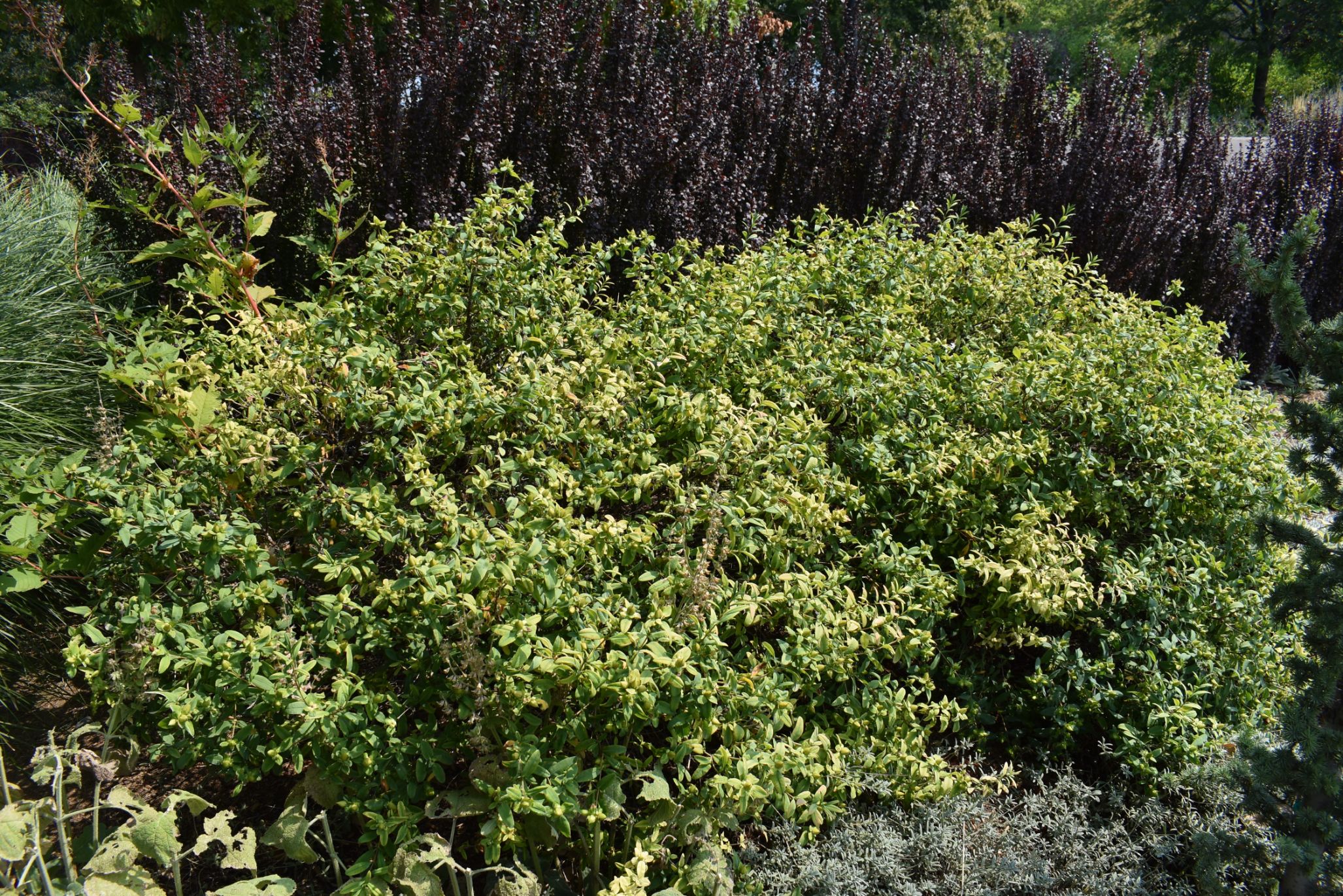
Sunburst St. John's Wort Hypericum frondosum 'Sunburst'
Dense and mounded shrubby perennial with oblong blue-green leaves. Large golden-yellow flowers bloom in early summer. Flowers are solitary and have a cluster of bushy stames in the center. Reddish-brown bark is exfoliating on mature stems. Topgrowth may not survive harsh winters but will quickly grow again from the roots. Tolerates some drought.
-

Sundial Lupine Lupinus perennis
Clump-forming plant with palmately compound leaves. Blue and purple pea-like flowers grow in spikes above the foliage in spring. Reseeds freely.
-
Sunflower Pawpaw Asimina triloba 'Sunflower'
A small deciduous tree native to the eastern US that produces delicious, golden yellow fruit. This Pawpaw is self-fertile and will not need another tree to produce fruit in the early fall, but planting a second variety for better pollination is recommended. The taste is like a combination of banana and mango, with creamy, spoonable, buttery flesh. The fruit isn't fully ripe until mottled with black and very soft. In addition to appealing fruit, this tree has cup-shaped, deep red to purple flowers that bloom in the spring, which attract beetle pollinators. Fall will turn the elongated foliage a golden yellow. Pawpaws are understory trees and are sensitive to full sunlight when young. Best practice is to cover seedlings with a shade cloth to create filtered shade while they're young, then remove the cloth once established to increase fruiting. Require moist, fertile soils and tolerate clay and alkaline soils.
-

Sungold Butterfly Bush Buddleja x weyeriana 'Sungold'
Dense heads of yellow-orange blooms adorn this very strong grower. A beautiful medium to large shrub flowering shrub which can be pruned back to desired height each year, even to the ground if desired. Once established, this plant is tolerant of many conditions. Attracts butterflies and bees.
-
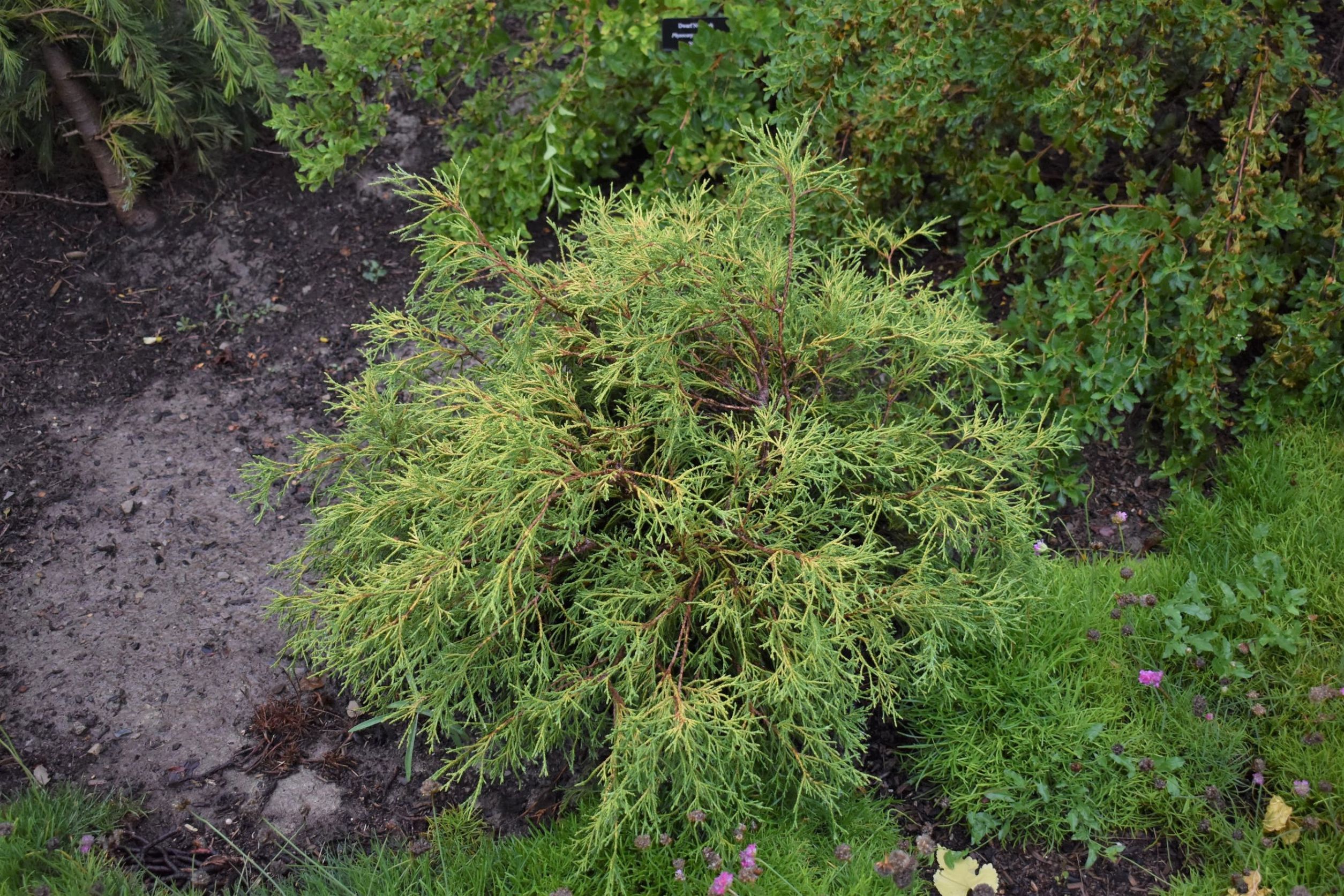
Sungold Thread-Branch Cypress Chamaecyparis pisifera 'Sungold'
A compact, mounding evergreen shrub that shines in the landscape with bright gold, finely textured foliage. New growth features these golden hues and later matures into a chartreuse green. The feathery foliage sits on draping branches, creating a beautiful weeping shape.
-

Sunjoy Gold Pillar Japanese Barberry Berberis thunbergii 'Maria'
This barberry cultivar has small oblong leaves that emerge red but mature quickly to golden yellow, which it retains all through the summer. Autumn temperatures turn the leaves to attractive shades of gold, red and orange. It has a columnar form which it will maintain with minimal pruning. It does have thorns, so be careful when handling. Soils are not a big deal and are easily handled by this shrub.
-

Sunjoy Todo Japanese Barberry Berberis 'NCBX1'
Sunjoy Todo has a neat, tight mounding habit. The deep purple foliage provides long-lasting color. Late spring brings yellow flowers that stand out against the dark leaves. These blossoms turn into red berries that do not carry seeds—making this barberry noninvasive.
-
Sunny Border Blue Speedwell Veronica 'Sunny Border Blue'
Showy clump-forming perennial. Dark-green, lance-shaped leaves have a wrinkled appearance. Tall spikes of violet blue flowers appear in late-spring and last through the summer. Removing spent blooms will promote additional flowering. Makes a great cut-flower. Grow in average, well-drained soils.
-

Sunny Seduction Yarrow Achillea millefolium 'Sunny Seduction'
This easy to grow perennial has soft yellow flowers that offer a bright showy summer display. Its fast-growing clumps of grey-green leaves form a compact, spreading mound. The flowers are great in cut flower displays.
-

Sunset Crater Penstemon Penstemon clutei
This Arizona native grows naturally in the volcanic cinder cone grit of Sunset Crater. It also thrives in Intermountain West landscapes in well-drained soils and gravel mulch. It is an easy re-seeder and will form large colonies of pink flowered plants.
-

Sunset Foxglove Digitalis obscura
A winning perennial foxglove featuring bell-shaped rusty-bronze flowers. The tall, graceful flower stalks can last for several weeks above the mounding stalks of thin, semi-evergreen, dark-green leaves. Prefers average conditions including regular deep watering. All foxglove leaves are poisonous to pets and humans.
-
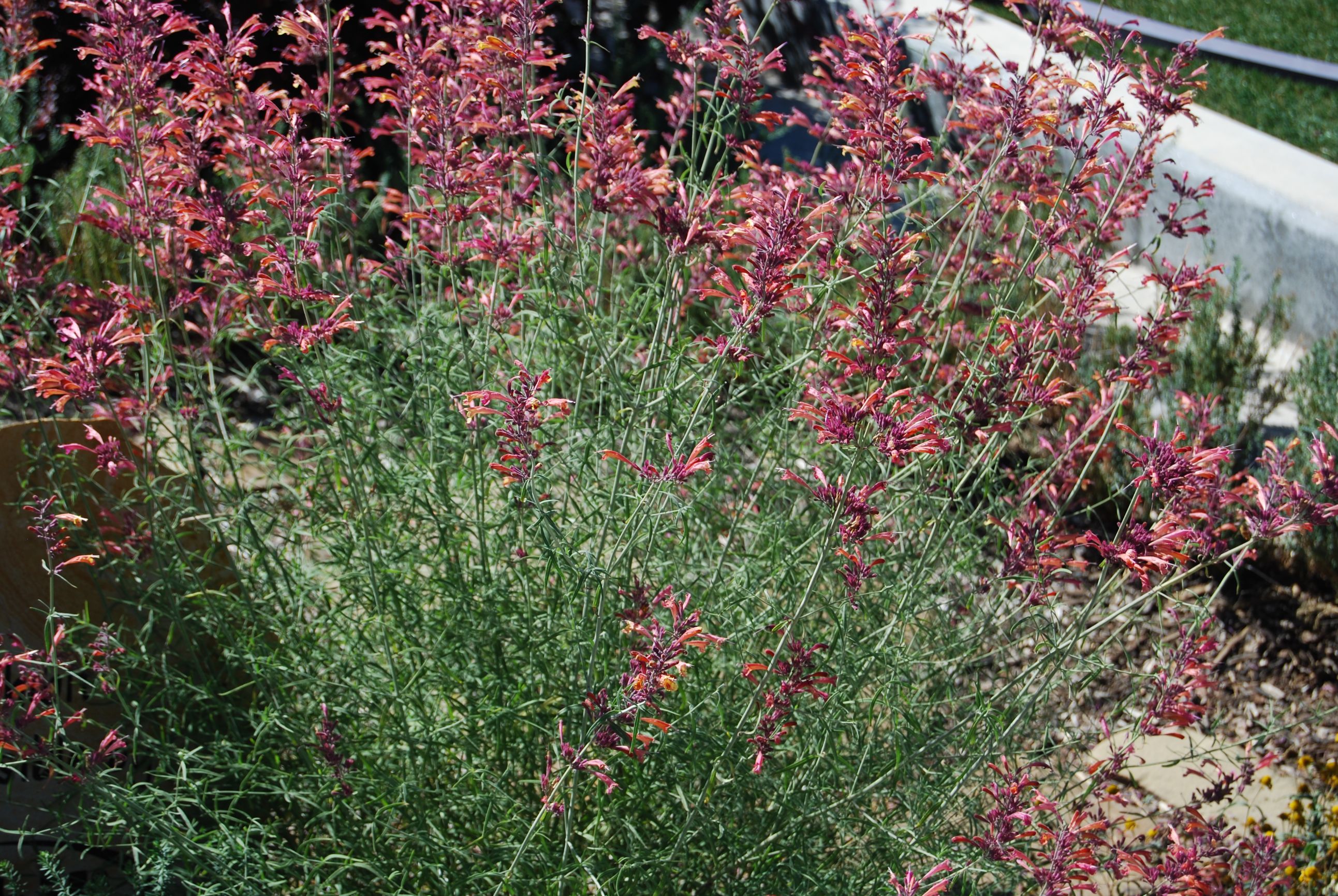
Sunset Hyssop Agastache rupestris
Upright growing fragrant perennial with a wispy look. Long-lasting bright orange-red blooms begin in mid-summer and last until the first freeze. Gray-green foliage emits a distinct root beer or licorice fragrance depending on your nose. Attractive to hummingbirds. Very drought tolerant but will use the water if it is available.
-
Sunshine Hollyhock Alcea rosea 'Sunshine'
Low mounds of large leathery leaves shoot up tall, sturdy stalks of yellow blossoms in the summer months. These flowers have a similar texture and transparency as crepe paper and make good cut flowers. The soft yellow petals lead down to a slightly darker eye. Due to their tall size during blooming season they are ideal for small back borders and screens, as well as pollinator gardens and planting beds that are in need of height.
-

Sunsparkler Firecracker Stonecrop Sedum 'Firecracker'
Mounds of plum purple foliage form this compact succulent. Soft sprays of pink flowers bloom in late summer. It works best as a ground cover and in rock gardens.
-

Sunsparkler Lime Twister Stonecrop Sedum 'Lime Twister'
The Sunsparkler Lime Twister hugs the ground with two-tone lime green succulent leaves that are edged in a creamy yellow color. Light pink flower clusters top the exciting foliage in late summer. In cool spring and fall weather, the creamy edges of the leaves can turn red in color.
-
Sunsparkler Lime Zinger Stonecrop Sedum 'Lime Zinger'
A succulent groundcover with lime-green foliage edged with cherry-red. Summer brings clouds of soft pink flower heads. It's very drought tolerant.
-
Sunsparkler Wildfire Stonecrop Sedum 'Wildfire'
This groundcover stonecrop displays vibrant, ruby-red foliage with lighter pink margins that lasts from spring through fall. Clusters of pink flowers can be enjoyed for several weeks in the late summer. Planting this sedum in full sun will bring out the best, most intense color.
-
Supreme Cantaloupe Coneflower Echinacea 'Cantaloupe'
This hardy, drought resistant perennial has peach-cantaloupe colored blooms that are showy from summer to fall. A dome of ruffled petals sits atop each stem. This has proven to be a relatively reliable cultivar in the garden.
-
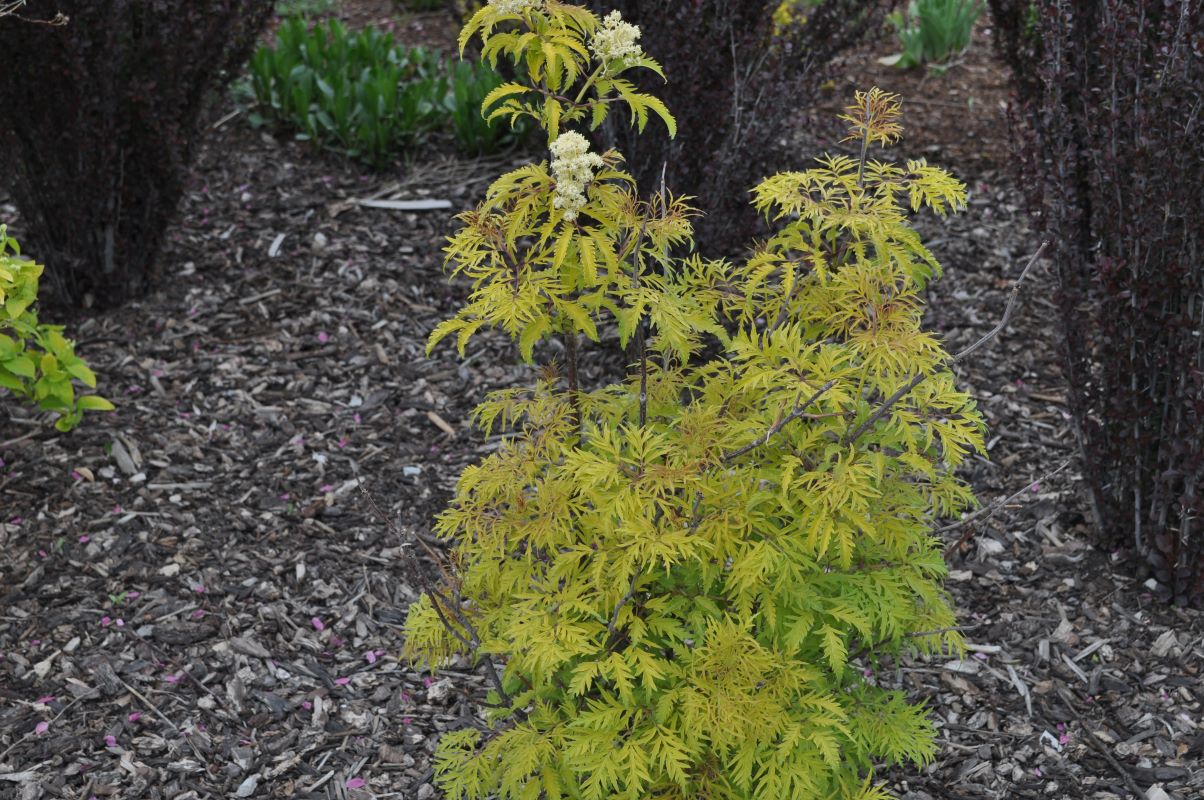
Sutherland Gold Elderberry Sambucus racemosa 'Sutherland Gold'
Small tree sometimes considered a large shrub. Finely dissected green foliage is bright and emerges bronze in March. Creamy white flower clusters appear in June. Flowers are star shaped and turn to red berries in the fall. The berries are edible if properly prepared.
-
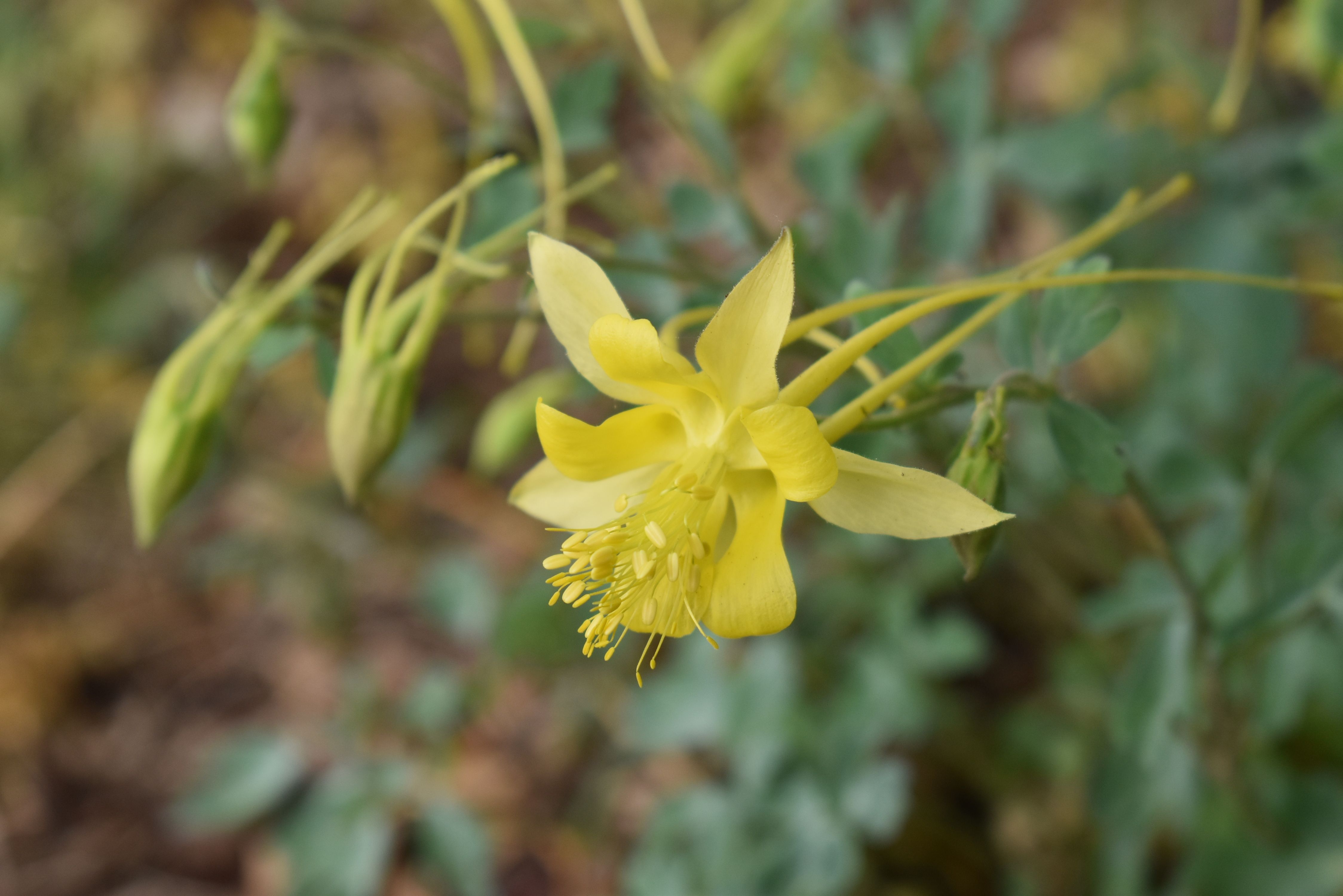
Swallowtail Columbine Aquilegia 'Swallowtail'
Large vigorous growing perennial native to Arizona. Bright yellow flowers with 4" long trailing spurs bloom in April. Blue-green fern-like foliage are also attractive. Will bloom longer if not too stressed by lack of water. Tolerates heat.
-

Swamp White Oak Quercus bicolor
A medium-sized deciduous tree, the swamp white oak is native to the swamps and lowlands of the eastern United States. The leaves are distinctly lobed and shiny green on top and silvery-white underneath. Fall color is usually yellow but can be a purple-red. Acorns mature in the fall. It prefers moist acidic soils but has shown some adaptability to drought. It may exhibit chlorosis in alkaline soils which requires the application of chelated iron. In our garden, we have planted them in a constantly soggy soil in a bio-swale area where other, more drought-tolerant trees have died.
-

Sweet Autumn Clematis Clematis terniflora
Deciduous, late-flowering, climbing vine with abundant sweet-scented, star-shaped flowers that cover the vine in late summer and lasting into fall, followed by attractive seed heads. Deep green leaves sometimes have silver central band. Prune lightly to remove dead wood. Great choice to soften arbors.
-

Sweet Woodruff Galium odoratum
Creeping, mat-forming perennial. Commonly used as a groundcover in shady areas. Spreads readily by roots and seeds. Mid-green leaves are lance-shaped and arranged in whorls. Prefers regular amounts of water and shade. Leaves emit a distinct odor when cut or crushed.
-
Saffron Crocus
The spice Saffron comes from this crocus as suggested in the name. When the plant blooms in the fall the stamens can be collected and used as dye and a spice. The small lavender colored flowers with yellow centers add a beautiful addition to the fall garden. Great when used in borders, rock gardens, and walkways.
Crocus sativus
Mature Size: 2-4" tall and wide
-

Sallyrosa April Night Sage
This is a new small salvia that blooms a month earlier than older varieties. It has a very long bloom period, producing flowers from late spring all the way through summer until frost. The violet flowers on tall spikes bloom above compact upright foliage. It is a perennial that is easy to care for, just cut the whole plant back after the first bloom fades to encourage more flower growth.
Salvia x sylvestris 'April Night'
Mature Size: 12-14" tall and wide
-

Salmon Beauty Yarrow
Long-flowering, spreading, mat-forming perennial. White to salmon pink flowers continue blooming throughout the summer. Fern-like foliage is slighty aromatic. Spreads easily by roots and by seeds. Grows well in many soil types but avoid especially heavy soils.
Achillea millefolium 'Lachsschönheit'
Mature Size: 30-36" tall x 24" wide
-

Samobor Dusky Cranesbill
Rich maroon flowers are held high above the semi-evergreen foliage, which is deeply lobed and streaked with burgundy. This graceful perennial thrives in shady areas and brings elegant charm to informal woodland gardens.
Geranium phaeum 'Samobor'
Mature Size: 16-20" tall x 12" wide
-
Sand Sagebrush
Freely branched, rounded shrub native to the Western United States. Slender, gray-green leaves provide a very soft texture. Prefers dry, coarse soils.
Artemisia filifolia
Mature Size: 3-4' tall x 4-5' wide
-

Sandwort
This evergreen plant is low-growing with a cushion-like habit and small white flowers that cover the plant in late spring. It grows well in between step stones, on rock walls, or along borders. With its attractive foliage, this hardy plant provides year-round interest. This plant can be grown in either sun or part shade but requires a soil medium with good drainage to thrive.
Arenaria tetraquetra
Mature Size: 2-4" tall x 12" wide
-

Santa Fe Maximilian Sunflower
Tall, autumn-blooming herbaceous perennial. One of the last perennials to bloom in the fall, and possibly one of the showiest. Golden yellow flowers bloom on stalks of beautiful green foliage. Will grow in any soil and will tolerate hot and dry conditions. Best used as a backdrop for other plants.
Helianthus maximiliani 'Santa Fe'
Mature Size: 6-8' tall x 4' wide
-
Santa Rosa Plum
Deciduous fruit tree. Produces dark-red to purple, lightly freckled plums. Inner flesh is yellow suffused with pink. The fruit is firm, juicy, sweet, and aromatic. Partially self-fertile but produces more heavily with polinizing. Vigorous and productive fruit producer. This cultivar is resistant to some diseases. Requires deep regular watering.
Prunus salicina 'Santa Rosa'
Mature Size: 15' tall x 10' wide
-
Sapphire Blue Flax
Purple blue flowers bloom in early to mid-summer on compact stems. The small, thin leaves are almost grass-like and grow along the stems. This variety is more compact than the species and extremely cold tolerant. It works great in naturalized areas or meadows. It will re-seed, which is a desirable feature for this lovely plant.
Linum perenne 'Sapphire'
Mature Size: 12-15" tall x 18" wide
-

Sarah Bernhardt Peony
Clump-forming herbaceous flowering perennial. Very large fragrant double flowers are bright rose-pink and bloom in late-spring. Glossy green foliage is deeply lobed and provides interest even when out of bloom. Plant in fertile and well-drained soils. Tolerates some drought once established.
Paeonia lactiflora 'Sarah Bernhardt'
Mature Size: 30-36" tall and wide
-
Saskatoon Serviceberry
This suckering, deciduous shrub is native to the western United States and has a variety of uses. The rounded green have good fall color. Clusters of delicate pure white flowers bloom in spring. June brings sweet purple-black berries that are loved by birds. Of all the species of serviceberry this is the most popular for human consumption, being the most flavorful. The berries resemble large blueberries in both look and taste, and are good eaten raw or cooked into jams and pies. Tolerant of alkaline soils.
Amelanchier alnifolia
Mature Size: 12' tall and wide
-

Scarlet Flame Phlox
This rock garden star blooms with masses of bright magenta flowers in the spring. The attractive carpet of foliage retains its presence into the summer.
Phlox subulata 'Scarlet Flame'
Mature Size: 4-6" tall x 18" wide
-

Scarlet Letter Oak
A narrow, columnar oak tree with dramatic red fall color. Its dense and sturdy branches resist wind and snow damage and make for a great privacy screen when planted in a row. This hardy hybrid of the White Oak and the English Oak can handle poor or alkaline soils and prolonged heat.
Quercus robur x alba 'Scarlet Letter'
Mature Size: 35' tall x 10' wide
-

Scarlet Meidiland Shrub Rose
Large, spreading, shrubby rose. Numerous non-fragrant, scarlet red double flowers, up to 3" wide, bloom continually through the summer. Dark green ovate foliage is slightly tinged red. Resistant to disease. Makes a great landscape rose and provides excellent summer color. Plant in masses or in hedges. Very care-free.
Rosa 'Meikrotal'
Mature Size: 5' tall x 8' wide
-

Scarlet Penstemon
This is penstemon is native to Utah and thrives in poor soil conditions. It is a clump-forming perennial with reddish-orange, two-lipped, tubular shaped flowers atop rigid stems blooming from late spring well into summer. The narrow, lance-shaped leaves resemble willow leaves. It likes inorganic mulch rather than compost.
Penstemon barbatus subsp. coccineus 'Scarlet'
Mature Size: 12-24" tall x 12-18" wide
-

Scentara Double Blue Lilac
Abundant clusters of bluish-purple, double-petaled flowers bring stunning fragrance in the spring. Excellent disease resistance and an elegant shape make this an easygoing and classic-looking shrub even after the spring blooms fade.
Syringa x hyacinthiflora 'SMNSHBBL'
Mature Size: 6-8' tall and wide
-
Scots Pine
This large evergreen tree has a uniform pyramidal shape in youth but becomes more open and picturesque with maturity. Its cinnamon-red bark is ornamentally flaky. The needles of this pine are a green to grey-green and come in bundles of two and are shorter than many other pines. It will tolerate difficult soils and some drought but does best with moderate moisture.
Pinus sylvestris
Mature Size: 30-70' tall x 20-35' wide
-

Sea Green Juniper
Compact vase-shaped arching evergreen shrub. Fine textured dark mint green foliage is scale-like but sharp when juvenile. Branches arch gracefully out from the base. Allow plenty of room to grow and spread. Very drought tolerant once established. Tolerant of alkaline and infertile soils.
Juniperus chinensis 'Sea Green'
Mature Size: 4-6' tall x 6-8' wide
-

Sea Kale
A traditional salt-tolerant perennial from the coasts of Europe, sea kale also works well in the Intermountain West. Large, waxy blue-green foliage grows in large clumps. Small white flowers grow in clusters in the spring. The young shoots can be eaten as a vegetable, resembling asparagus or cabbage.
Crambe maritima
Mature Size: 24" tall x 24-30" wide
-

Sea of Gold Juniper
A compact, evergreen shrub with feathery, yellow-gold foliage. It retains its gold color better than other junipers even deepening in the winter. Once established, it handles difficult soils and drought very well.
Juniperus x pfitzeriana 'Monsan'
Mature Size: 3' tall x 4' wide
-
Sea Thrift
Neat evergreen tufts of green grass-like foliage grow on woody stems that spread along the ground, forming a soft carpet. In spring, a profusion of 1" wide spherical pink flower heads create a "sea" of pink. Deadheading will extend flowering time. Makes a great groundcover for sunny open areas, but can't handle very much foot traffic.
Armeria maritima
Mature Size: 8" tall x 12" wide
-

Sebastian Maas Peony
Clump-forming herbaceous flowering perennial. Large, highly fragrant pink flowers are semi-double with serrated edges and outer petals which fan out. Flowers bloom in late-spring. Attractive glossy green foliage is deeply-lobed. Plant in fertile well-drained soils. Tolerates some drought once established.
Paeonia lactiflora 'Sebastian Maas'
Mature Size: 32" tall and wide
-

Seckel Pear
Small, deciduous, fruit-bearing tree. Pure white flowers bloom in mid-spring turning to small, yellow-brown fruits with red blush that ripen in September. Also called candy pear or sugar pear, this pear variety makes an excellent dessert pear. Requires moderate amounts of water to support fruit growth. Pruning and pest control are required on fruit trees. This variety is resistant to fire blight.
Pyrus communis 'Seckel'
Mature Size: 15-20' tall x 10' wide
-

Select Blue Catmint
Attractive and long-blooming member of the mint family. Covered with lavender blue blossoms starting in late spring and will rebloom in the late-summer if deadheaded promptly. The fragrant gray-green foliage is attractive and will provide interest even out of bloom. This variety is sterile and so is not as aggressive as other catmints. A great choice for any low-water landscape.
Nepeta x faassenii 'Select Blue'
Mature Size: 15" tall x 18" wide
-

Sensation Boxelder
The leaves of this hardy tree emerge copper red, fading to green with red highlights in the summer then turning bright red in the fall. It is highly adaptable to site conditions including wet or dry soils. It's form is pyramidal in youth then spreading with age, with a single silvery trunk. This seedless variety is less attractive to boxelder bugs.
Acer negundo 'Sensation'
Mature Size: 30' tall x 25' wide
-

Sensation Lilac
Upright growing deciduous shrub. Panicles of fragrant lavender-purple, white edged flowers bloom in spring. Green cordate leaves have no fall color. Tolerates many soil types but no extremes. Quite drought tolerant once established.
Syringa vulgaris 'Sensation'
Mature Size: 8-15' tall x 6-12' wide
-
Serbian Spruce
Narrowly pyramidal evergreen conifer. One of the best spruces for the landscape due to its tolerance of urban conditions. Dark green needles have light colored stomatal stripes. Graceful branches grow all the way to the ground. Said by some to resemble the Douglas Fir. Bark is reddish-brown. Cones are roughly egg-shaped. Prefers moist, fertile soils but is tolerant of other conditions.
Picea omorika
Mature Size: 45-50' tall x 15-20' wide
-

Seven Son Flower
Large deciduous shrub native to China. Clusters of fragrant white flowers are grouped in clusters of seven and bloom in late-summer to fall. As the blossoms gently fall to the ground they reveal vivid red, fan-like bracts. These bracts act as a second wind of colorful interest, looking like blossoms in an all new color. Usually grown with multiple stems, but it can be trained to grow on one trunk. Green leaves are simple and 2-6" in length. Exfoliating tan bark is attractive and adds to the overall beauty of this plant. Not particularly drought tolerant.
Heptacodium miconioides
Mature Size: 20' tall x 8-10' wide
-

Shademaster Honeylocust
A medium-sized shade tree with an excellent vase shape and finely-spaced upward branches. Although the species has thorns and large pods, this variety is thornless and typically won't produce pods. The leaves are fernlike and composed of numerous leaflets, creating light dappled shade and making fall clean-up easy. The green rounded leaflets have serrated edges and will turn yellow in autumn. Flowers are yellow and insignificant. Very tolerant of dry and compacted soils as well as periods of drought and excess moisture.
Gleditsia triacanthos f. inermis 'Shademaster'
Mature Size: 50-70' tall x 30-50' wide
-

Shadow Mountain Penstemon
A beautiful hybrid penstemon with constantly blooming small, lavender pink flowers through out the summer. Narrow, lance-shaped, bright-green foliage is semi-evergreen. Prefers full sun and moist, well-drained soil. Attracts hummingbirds and butterflies and is deer resistant.
Penstemon x mexicali 'Psmyers'
Mature Size: 18" tall x 12" wide
-

Shadscale
Upright-growing shrub native to Utah. Gray-green leaves have been described as looking like "cornflakes on a stick." Leaves turn salmon-peach in the fall and winter. Flowers bloom in late-spring to summer and are inconspicuous. Very tolerant of salt and drought. Will not tolerate over-watering.
Atriplex confertifolia
Mature Size: 3' tall and wide
-

Shaggy Dog Eastern White Pine
This dwarf, wide spreading white pine is unique in its overall growth habit. Branches spread out both upwards and downwards, creating the “shaggy dog” look that lead to this evergreen’s name. The foliage is mid green and shorter in size compared to others within the species.
Pinus strobus 'Shaggy Dog'
Mature Size: 4' tall and wide
-

Shangri-la Sage
Shangri-la Sage offers wide, sturdy leaves that have an appealing shade of grey-green. Flower stems rise high above the foliage with showy lavender-blue blossoms. The uniquely shaped flowers have a pale blue lip which is tinged and spotted with purple accents. Perfect for informal xeric or rock gardens.
Salvia indica x moorcroftiana
Mature Size: 2-3' tall and wide
-

Shasta Daisy
Clump-forming perennial with dark green, lance-shaped foliage. Large, solitary, white flowers with yellow centers bloom in early to late summer. Prefers well-drained, moist soils. Tolerates some drought. Very showy, suitable for most landscape situations.
Leucanthemum x superbum
Mature Size: 3-4' tall x 1-2' wide
-
Shawnee Brave Bald Cypress
This tall, conical, cone-bearing tree grows more narrow and with denser foliage than the species. This conifer loses its needles in the fall and winter, making it deciduous. The species grows naturally in swampy areas but will tolerate less water and somewhat dry conditions. It prefers acidic soil and should not be planted in soils with a pH higher than 7.5. Attractive light to mid green needles are quite flat and turn a bronze brown in the fall before falling off the tree. The base of the trunk is quite broad, even in youth and may form knobby "knees" in especially wet areas.
Taxodium distichum 'Shawnee Brave'
Mature Size: 15-75' tall x 15-20' wide
-

Shenandoah Switch Grass
The foliage of this switchgrass cultivar emerges blue-green but turns burgundy with age. It has a tight upright form that resists flopping. It is tolerant of many types of soil and amounts of water. It will tolerate some shade. The species is native from Utah to the east coast.
Panicum virgatum 'Shenandoah'
Mature Size: 3-4' tall and wide
-
Shepherd's Warning Bloody Cranesbill
Vibrant pink flowers emerge from thick mats of deeply cut foliage, shining in mass plantings or borders. The semi-evergreen foliage and long-blooming flowers bring lush color earlier and longer than most plants.
Geranium sanguineum 'Shepherd's Warning'
Mature Size: 5-9" tall x 12-24" wide
-

Shimmer Evening Primrose
The narrow leaves of this variety create fluffy mounds of silvery-gray foliage. In the spring a burst of three inch bright yellow flowers start off the season with more sporadic blooming through the summer. This variety is drought tolerant and adapted to the soils of the Intermountain region.
Oenothera fremontii 'Shimmer'
Mature Size: 10" tall x 15" wide
-

Shirley Temple Peony
Clump-forming herbaceous flowering perennial. Large fragrant white double flowers blushed with pink bloom in late-spring. Flowers are excellent for cutting. Deeply lobed glossy green foliage provides attraction even when out of bloom. Plant in fertile well-drained soils. Tolerates some drought once established.
Paeonia lactiflora 'Shirley Temple'
Mature Size: 24-30" tall x 30-36" wide
-

Shirley's Joy Hens and Chicks
Low-growing perennial succulent with rosettes of thick pale green-gray leaves covered with a fuzz of soft white hairs. Leaf tips turn red seasonally. After blooming pale pink in summer, the rosettes will die but are replaced by new offset rosettes. Plants require excellent drainage and little water. Avoid excessively wet winter soil. Great choice for rock gardens, crevices, or well-drained pots.
Sempervivum 'Shirley's Joy'
Mature Size: 6" x 12"
-

Showy Goldeneye
One of Utah's native plants, this one provides cheery summer color and works well for informal native or prairie plantings. It will flower the first year, and the small, golden, daisy-like flowers will continue from July to September. Under ideal conditions it can be aggressive, but it is easily controlled.
Viguiera multiflora
Mature Size: 6" tall and wide
-

Showy Milkweed
Showy Milkweed is a common native wildflower that serves as a host plant for Monarch butterflies. The caterpillars feed on the large oval leaves while the mature butterflies drink the nectar from the flowers. Due to a substance in the plants, Monarchs become toxic to their predators. In late spring and early summer, the flowers form interesting spiky spheres in shades of pink. In the fall, large seed pods break open to release clouds of fluffy seeds. Spreads easily by underground rhizomes and from seed; here in the Garden it is confined to certain areas so as not to invade the rest of the Garden.
Asclepias speciosa Torr.
Mature Size: 18-36" tall x 24-36" wide
-

Siberian Bugloss
This clump-forming perennial spreads by self-seeding and rhizomes, eventually forming a mat of green, heart-shaped foliage. Clusters of flowers that resemble those of the forget-me-not appear in early-spring. The common name, "bugloss," is derived from the Greek word for ox-tongue and is in reference to the rough texture of the leaves. This bugloss prefers to grow in shade and is intolerant of drought.
Brunnera macrophylla
Mature Size: 12-18" tall x 18-30" wide
-

Siberian Peashrub
Large thorny upright shrub native to Siberia and Mongolia. Bright green pinnately compound leaves grow on bright green branches. Brilliant yellow pea-like flowers bloom in spring followed by greenish-brown seed pods. Tolerates extreme cold, drought, and poor soils. Siberian Peashrub is known to be invasive in the midwestern US.
Caragana arborescens
Mature Size: 15-20' tall x 12-15' wide
-
Siberian Squill
Early spring flowering bulb with basal, grass-like leaves. The drooping, star-shaped blossoms sit on tall slender stems. The stars are an attractive shade of blue, with a dark blue strip down the middle of each petal. The stamens are white with dark blue tips. It is hardy and highly tolerant of cool temperatures.
Scilla siberica
Mature Size: 4-6" tall and wide
-

Sicilian Honey Lily
A spring blooming bulb that produces dainty, dangling bell-shaped flowers on tall, slender, green stems. The blossoms are a combination of white, pink and purple color. If they get bruised, they will give off an odor similar to onions.
Nectaroscordum siculum ssp. Bulgaricum
Mature Size: 36-48" tall x 5-8" wide
-
Sideoats Grama
Clump-forming ornamental grass. Long, slender, gray-green leaves grow basally up to 18" long. Tall spikes of purple, oat-like inflorescences grow in summer and only on one side of the stem. Native to Missouri prairies. Tolerant of a wide range of soil conditions. Grow well in dry soils.
Bouteloua curtipendula
Mature Size: 18-30" tall x 18-24" wide
-

Sienna Sunset Coreopsis
A thread leaf coreopsis that offers burnt sienna colored blossoms that gently fade to a softer orange yellow as they mature. Spreads with rhizomes. Great for edging, border of sidewalks or in naturalized areas. Also good as a container plant.
Coreopsis rosea 'Sienna sunset'
Mature Size: 12-18" tall x 12-24" wide
-
Siloam Little Girl Daylily
Tall herbaceous perennial with 4" pink summer-blooming flowers with rose eyes. Foliage is long and drooping with grasslike blades about 1 inch wide. Easily grown in a wide range of conditions. As suggested by the name, flowers last one day but are produced over a long period of time. Divide every 3-5 years to maintain vigor.
Hemerocallis 'Siloam Little Girl'
Mature Size: 2-3' tall x 2' wide
-

Silver Blade Evening Primrose
Similar to the species, this trailing perennial produces large, sunny yellow flowers from late-spring to fall. The leaves of this variety have a silver hue that makes them stand out in the landscape. They can be aggressive spreaders and can be easily cut back if they get too leggy.
Oenothera macrocarpa ssp. incana 'Silver Blade'
Mature Size: 6" tall x 18" wide
-

Silver Buffaloberry
Spiny, deciduous, suckering, large shrub or small tree. Closely resembles a small Russian Olive. Oblong gray-green leaves turn brown in autumn. Inconspicuous, but interesting, yellow flowers bloom in early spring. Produces edible red berries. Vigorously growing and difficult to prune. Can be used as a barrier or in naturalized, low-maintenance situations.
Shepherdia argentea
Mature Size: 6-12' tall x 6-10' wide
-

Silver Butterfly Bush
Beautiful medium to large flowering shrub. Can be pruned back to desired height each year, even to the ground if desired. Once established, this plant is tolerant of many conditions. Attracts butterflies and bees. A 1998 Plant Select Winner. This silver-leafed variety has lavendar-purple colored blooms.
Buddleja alternifolia 'Argentea'
Mature Size: 10-12' tall x 8' wide
-
Silver Carpet Lamb's Ear
Low-growing, semi-evergreen perennial that forms a mat of thick, velvety, silver-gray foliage. Leaf resembles a lamb's ear, hence the name. This cultivar rarely blooms, giving it a tidier appearance. Spreads readily especially in very fertile soils. Semi-evergreen depending on the climate. Tolerant of drought. Susceptible to disease in humid summers. Prefers well drained soils.
Stachys byzantina 'Silver Carpet'
Mature Size: 6-8" tall x 12-18" wide
-
Silver Edged Horehound
Low-growing, vigorous, evergreen perennial. Beautiful gray-green soft felt-y leaves have silver-white edges and undersides. Flowers are insignificant and may be sheared off. Works well as a groundcover or in rock gardens Prefers poor well-drained soils and requires very little water once established. Also referred to as Silverheels Horehound.
Marrubium rotundifolium
Mature Size: 10" tall x 18" wide
-

Silver Feather Maiden Grass
Large clump-forming ornamental grass. Long and slender green leaves contrast nicely with the silvery-white plumes of flowers that appear in late-August. Provides wonderful appeal if left standing through the winter. Cut back in the early spring, before new growth appears.
Miscanthus sinensis 'Silberfeder'
Mature Size: 6-8' tall x 4' wide
-

Silver Linden
Large conical deciduous tree with fragrant, creamy yellow flowers that bloom in the summer. Large heart-shaped glossy-green leaves have serrated edges and are silver underneath. Leaves turn muted green to pale-yellow in the autumn before falling. Branches grow densely upright and may need some pruning to promote healthy structure. Tolerant of alkaline soils and grows best with moderate water.
Tilia tomentosa
Mature Size: 50-70' tall x 30-50' wide
-
Silver Mist Himalayan Cedar
Densely packed, conical evergreen prized for its flushes of snowy white, new growth. As ‘Silver Mist’ matures a terminal leader may emerge, but the general shape will stay compact when compared to others of its kind, making it great for smaller spaces.
Cedrus deodara 'Silver Mist'
Mature Size: 4-10' tall x 2-3' wide
-

Silver Moon Clematis
Compact early-flowering climbing vine. Silver-grey to lavendar 4-6" blossoms appear in late spring. Group 2 type clematis. Very little pruning required as blooms appear on second year's growth. Will tolerate some shade.
Clematis 'Silver Moon'
Mature Size: 6-8' tall x 3' wide
-
Silver Sage
This biennial boasts large fuzzy silver leaves that are soft to the touch and provide beautiful textural contrast in the garden. The leaves have wavy margins and grow in a rosette shape. Flower spikes emerge in the summer of its second year, developing into dramatic 3-foot candelabras topped with small white flowers.
Salvia argentea
Mature Size: 2-4' tall x 1-2' wide
-
Silverberry
Large, upright, deciduous shrub native to Utah and much of the western United States. Silver-grey leaves are lanceolate. Small yellow flowers bloom in late-spring to early-summer and turn to pulpy, silver-grey fruits.
Elaeagnus commutata
Mature Size: 10-12' tall x 4-6' wide
-

Singing in the Rain Itoh Peony
Large, semi-double, creamy yellow peony blossoms come in late spring and as they mature into the early summer, they take on peachy-coral shades. On top of being beautiful and showy, these blossoms add a soft fragrance to the area. This shrubby perennial is sure to add splashes of color and sweet aromas along borders and in focal areas. Itoh peonies, or intersectional peonies, are hybrids of the tree peony (P. lemoinei) and garden peony (P. lactiflora).
Paeonia 'Singing in the Rain'
Mature Size: 2-3' tall x 3-4' wide
-
Single Apricot Chrysanthemum
A compact, mounded perennial, this chrysanthemum is at its most beautiful just before frost. Profuse daisy-like blooms appear in October and glow with rays in a soft apricot hue with yellow centers. It prefers plenty of moisture and organic soils but will tolerate and bloom in less than optimal conditions. The leaves are dark green and lobed with a distinct aroma when touched.
Chrysanthemum 'Single Apricot'
Mature Size: 18-36" tall x 18-24" wide
-

Singleleaf Ash
A small tree native to Utah and the southwestern United States. Single, mid-green leaves are ovate and slightly serrated on the edges. In autumn the leaves turn a bright yellow before falling. It is the only member of the genus that does not have compound leaves. Inconspicuous white flowers turn to elongated seed pods in summer. This tough tree can handle poor soils and dry conditions once established.
Fraxinus anomala
Mature Size: 8-12' tall and wide
-
Singleleaf Pinyon
This tough pine tree is native to the southwestern United States including Utah. It is very slow-growing and will take decades to reach it's maximum 15 feet in height. Bluish-gray needles are its best characteristic, making it a natural look for desert landscapes. It grows well in alkaline soils but prefers well-drained sites.
Pinus monophylla
Mature Size: 8-15' tall x 4-8' wide
-

Sioux Blue Indian Grass
Upright growing, clump-forming ornamental grass. Powder-blue leaves grow about 1/2" wide turning yellow to gold in the fall. Tan inflorescenses appear in mid to late-summer and grow on thin stalks above the plant. Tolerant of drought and poor soils. Fertile soils may cause the plant to flop and aggresively reseed. The species is native from Utah to the east coast.
Sorghastrum nutans 'Sioux Blue'
Mature Size: 3-5' tall x 2-3' wide
-

Six Hills Giant Catmint
This tall catmint is also one of the hardiest varieties. It also has one of the longest bloom times of all catmints. It is broad, vigorous, and free flowering in a deep violet-blue blossoms. This plant likes dry, poor soils. Cut back to the ground after first blooms fade to encourage a second bloom.
Nepeta 'Six Hills Giant'
Mature Size: 2-3' tall x 1-2' wide
-
Skandia Juniper
Low-growing, spreading evergreen shrub. Low, arching branches are densely layered and compact with gray-green to green linear foliage. Requires full sun and very little water once established. Resistant to juniper blight. Tolerates alkaline and infertile soils. Very low maintenance.
Juniperus sabina 'Skandia'
Mature Size: 12-18" tall x 8' wide
-

Sky Blue Aster
An easy-going showy perennial that goes all-out in fall with masses of light purple-blue flowers. The small daisy-shaped flowers have delicate petals and yellow to brown centers, while the leaves transition from thin at the top of the plant to heart-shaped at the bottom. Grows well in a variety of soil and sun conditions.
Aster azureus
Mature Size: 2-3' tall x 1-2' wide
-

Sky Trails Serbian Spruce
Narrow, pyramidal evergreen conifer. Serbian spruce is one of the best spruces for the landscape due to its tolerance of urban conditions. Deep green to blue-green needles have silvery colored stripes; providing a pleasing contrast. Graceful branches grow all the way to the ground. Sky Trails has a tall, upright, weeping habit and resembles Douglas fir. Bark is reddish-brown. Cones are roughly egg-shaped. Prefers moist, fertile soils but is tolerant of other conditions.
Picea omorika 'Sky Trails'
Mature Size: 30-35' tall x 8-10' wide
-
Skyline Honeylocust
A medium-sized shade tree with an excellent pyramid shape, a strong main trunk, and evenly spaced, gently swooping branches. Although the species has thorns and large pods, this variety is thornless and typically won't produce pods. The leaves are fernlike and composed of numerous leaflets, creating light dappled shade and making fall clean-up easy. The green rounded leaflets have serrated edges and will turn yellow in autumn. Flowers are yellow and insignificant. Very tolerant of dry and compacted soils as well as periods of drought and excess moisture.
Gleditsia triacanthos f. inermis 'Skyline'
Mature Size: 50-75' tall x 35-50' wide
-
Skyrocket Juniper
Columnar, upright-growing evergreen tree or tall shrub. Scale-like leaves vary in color from grey-green to blue-green. Branches grow upward creating a dense, columnar tree perfect for formal landscapes and areas needing wind and privacy screens. The spread can vary within this cultivar. Requires little maintenance and retains its shape quite well. Prefers drier soils, avoid overwatering. It works well in formal settings.
Juniperus scopulorum 'Skyrocket'
Mature Size: 15' tall x 3-5' wide
-

Slenderleaf Mountain Mint
This herbaceous perennial offers clusters of vivid white blossoms that bloom throughout the summer. The foliage is highly narrow and almost needle-like. Mountain mint also provides fragrance and culinary benefits. When crushed, all parts of the plant give off a minty aroma and the leaves have been used in teas.
Pycnanthemum tenuifolium
Mature Size: 2-3' tall and wide
-
Slowmound Mugo Pine
Very slow-growing compact variety of mugo pine. Short dark green needles are very attractive and provide a uniform appearance. Forms a dense mound that will not outgrow the landscape. Requires very little pruning. Provide well drained soils. Will tolerate some drought once established.
Pinus mugo 'Slowmound'
Mature Size: 2-4' tall and wide
-

Small Woodland Sunflower
This perennial wildflower has green, spear-head shaped leaves. Midsummer brings an abundance of dainty, bright yellow, daisy-like blossoms. Plant Small Woodland Sunflower in mass groupings to give the landscape a large flush of color.
Helianthus microcephalus
Mature Size: 4-6' tall x 2-3' wide
-

Smoky Hills Skullcap
A woody based perennial with branching, upright stems. It has rounded leaves that are gray-green in color. The tubular, lavender-blue flowers have two white stripes. It blooms for most of the summer and is a great addition to a hot, sunny rock garden. This plant is a member of the mint family but doesn’t have much fragrance. It prefers well-drained soils and is okay with rocky growing areas.
Scutellaria resinosa 'Smoky Hills'
Mature Size: 10-12" tall x 12-15" wide
-

Smooth Sumac
This large thicket-forming shrub can spread aggressively and take over large areas if left unchecked. Large compound leaves are made up of lance-shaped leaflets. Fall changes the leaves from green to bright shades of orange and red. Inconspicuous flowers turn into large cone-shaped clusters of dark red, fuzzy fruit. Tolerant of a wide range of soils except overly wet ones.
Rhus glabra
Mature Size: 9-15' tall and wide
-
Snow Day Surprise Pearl Bush
White flowers cover this shrub like snow throughout spring. This is a hardier selection than the standard pearl bush and has a neater, more rounded and compact habit. The oval-shaped deciduous leaves turn yellow in fall.
Exochorda 'Niagara'
Mature Size: 3-5' tall and wide
-

Snow Flurry Aster
The leaves of this groundcover perennial are heath-like. It forms a dense mat of foliage that produces abundant white flowers with yellow centers. It is very drought tolerant and prefers full sun, but will tolerate light shade. It's attractive to butterflies and other pollinators when in bloom. Also known as Symphyotrichum ericoides 'Snow Flurry'.
Aster ericoides 'Snow Flurry'
Mature Size: 4-6" tall x 6-12" wide
-
Snow Queen Phlox
Snow Queen Phlox forms a tidy, dense mound of dark green, narrow, needle-like foliage. The spring brings an abundance of dainty, pure white blossoms that sit on top of the leaves. This phlox enjoys being in sunny rock gardens, along walkways or in pots.
Phlox 'Snow Queen'
Mature Size: 2-6" tall x 12-18" wide
-

Snow White Mock Orange
Multi-stemmed deciduous shrub with upright arching brances. Profuse white flowers are double and very fragrant. Blooms begin in late spring and last up to 4 weeks. Tolerates some shade but produces more flowers in full sun. Requires low to moderate amounts of water. Adaptable to many soil types.
Philadelphus 'Snow White Fantasy'
Mature Size: 4-5' tall x 4-6' wide
-

Snow-in-Summer
Rampant, mat forming perennial producing white or silvery woolly leaves. Profuse amounts of star shaped five petalled 1" white flowers bloom in late spring to summer. Tolerates a wide range of soils as long as they are well-drained. Great for ground covers or rock gardens. Prefers full sun.
Cerastium tomentosum
Mature Size: 4-6" tall x 6-12" wide
-

Snowball Viburnum
Also known as European Cranberrybush, this bushy, round shrub is eye-catching in more than one season. Late spring brings large round clusters of flowers resembling snowballs that change from soft green to white to pale pink, making for great cut flowers. In the fall, maple-shaped leaves turn striking shades of orange and red. This is a sterile cultivar with no berries.
Viburnum opulus 'Roseum'
Mature Size: 10-12' tall x 12-14' wide
-

Snowberry
Upright, arching, thicket-forming shrub. Mid-green, oval leaves usually have smooth edges but can be somewhat lobed. Pinkish-white, bell-shaped flowers bloom in the summer. Forms clusters of rounded pure-white berries. Though not toxic, the berries are best left on the bush. Plant in well-drained soils. Performs well as an understory plant.
Symphoricarpos albus
Mature Size: 3-6' tall and wide
-
Snowcap Shasta Daisy
Dwarf clump-forming perennial with dark green, lance-shaped foliage. Large, solitary, white flowers with yellow centers bloom in early to late summer. Prefers well-drained, moist soils. Tolerates some drought. Very showy, suitable for most landscape situations.
Leucanthemum x superbum 'Snowcap'
Mature Size: 18" tall x 10" wide
-

Snowdrop
One of the earliest spring blooming flowers, often blooming when snow is still on the ground. Nodding, white, bell-shaped flowers bloom above slender grass-like leaves.
Galanthus nivalis
Mature Size: 6-8" tall x 4-6" wide
-

Snowflake Oakleaf Hydrangea
Large, snowy-white clusters of flowers adorn this hydrangea throughout the summer. This species is better able to tolerate alkaline soils than some of its cousins. Its deeply lobed leaves resemble those of an oak. Will handle some shade but it needs plenty of water for it to thrive.
Hydrangea quercifolia 'Snowflake'
Mature Size: 4-6' tall and wide
-

Snowhill Meadow Sage
Compact herbaceous perennial with spikes of snow white flowers that bloom profusely in June and continue sporadically through the summer. Green leaves with serrated edges are quite large at the base with smaller leaves growing from the stems. Remove spent blossoms to promote additional blooming.
Salvia x sylvestris 'Snow Hill'
Mature Size: 18-24" tall x 12-18" wide
-

Snowmound Spirea
Compact, mounding deciduous shrub. Green ovate leaves grow on arching stems. Pure white flowers grow in abundant clusters in mid to late-spring. Vigorous growing, may spread. Tolerates a wide range of soils but prefers moderate amounts of water.
Spiraea nipponica 'Snowmound'
Mature Size: 2-4' tall and wide
-

Soapwort
A low-growing semi-evergreen groundcover, soapwort makes a carpet of pink flowers over green foliage. It is very vigorous and will spread both by rhizomes and seeds, so put it in a place that it has room to stretch. It makes a good filler for crevices in rock walls and grows well in colder climates. Shearing the flowers as they fade will keep them from reseeding.
Saponaria ocymoides
Mature Size: 8" tall x 24" wide
-
Sol Dancer Daisy
Cheerful and everblooming, Sol Dancer Daisy handles heat, drought and poor soils. Large, bright yellow blooms on sturdy stems appear in late spring and continue until frost. Foliage is grass-like, uniform and deer resistant. Sol Dancer prefers good drainage and appreciates a gravel mulch that encourages re-seeding. In order to encourage re-seeding, do not deadhead all spent blooms. Needs little water once established. A Utah State University Sego Supreme introduction. Also known as Four-nerve daisy.
Tetraneuris (syn Hymenoxis) acaulis var. arizonica 'Sol Dancer'
Mature Size: 15" tall and wide
-

Solitary Clematis
Summer blooming herbaceous perennial with 2" blue flowers. Forms a gradually expanding clump of stems arising from the center. Each stem is topped with one flower. Group 3 type clematis. Cut back to 2" from the center every year.
Clematis integrifolia
Mature Size: 36" tall and wide
-

Sombrero Blanco Coneflower
This perennial has compact mounds of green foliage. It features bright white flowers with an exceptionally long bloom season. It is a great low maintenance choice for a summer, sunny border or a cutting garden. Cold hardy and drought tolerant once established.
Echinacea purpurea 'Balsomblanc'
Mature Size: 18-20" tall x 22-24" wide
-
Sombrero Flamenco Orange Coneflower
This sturdy and compact coneflower offers an abundance of large, single flowers with vibrant orange-red petals surrounding a brown cone center. The blooming period starts midsummer and continues through early fall. As the seed heads dry, they can be left up for hungry birds or to add winter interest.
Echinacea x hybrida 'Balsomenco'
Mature Size: 23-25" tall x 18-20" wide
-

Song Siren Laura Yarrow
Hardy perennial with ferny foliage and flat-topped flower clusters. Long-blooming ruby-red flowers with white centers open in early-summer and last until fall. Gray-green aromatic leaves are unappetizing to deer. Flowers may be used as decorations when dried. Tolerates many soil types and low amounts of water. Clumps will spread, but not uncontrollably.
Achillea millefolium 'Laura'
Mature Size: 20-22" tall x 12-14" wide
-
Sonoran Sunset Hyssop
A native of New Mexico, this hyssop features tubular, sweetly fragrant, purple flowers arranged in whorls on salvia-like spikes. Has a long bloom time from June to September. Prefers full sun and low moisture. Non-invasive. Atractive to butterflies and bees.
Agastache cana 'Sinning'
Mature Size: 18" tall and wide
-

Sorbet Peony
Sorbet Peony displays glossy green leaves that show off the luscious blossoms beautifully. In late spring bright pink buds form which mature into blush-pink and creamy white double blossoms. They are lightly fragrant and great as a cut flower. The foliage turns red in the fall.
Paeonia lactiflora 'Sorbet'
Mature Size: 30-36" tall and wide
-

South Seas Daylily
The flowers of this daylily vary from mango to scarlet in late-spring through summer. Its leaves are long and linear and grow from the base of the plant. It is hardy and can handle Utah's climate but needs consistent water.
Hemerocallis 'South Seas'
Mature Size: 25-30" tall x 18-24" wide
-

Southern Belle Hardy Hibiscus
Vigorous compact herbaceous perennial. Large white flowers grow up to 10 inches in diameter with a dark red eye. Blooms open during the summer months and last for one day with multiple blooms opening each day. Large dark green serrated leaves complete this lovely perennial creating a beautiful plant. Tolerates heat and will adjust to different soils but prefers fertile organic soils. Needs evenly moist soil.
Hibiscus moscheutos Southern Belle Group
Mature Size: 3-4' tall x 2-3' wide
-

Southern Charm Mullein
This showy perennial is characterized by blush pink flowers with dark purple centers that grow on tall stems. The leaves grow basally and are large and deeply veined. It will bloom repeatedly through the summer if located in the right spot. If flowers are not deadheaded it will self seed.
Verbascum 'Southern Charm'
Mature Size: 2-3' tall x 1-2' wide
-

Souvenir d' Andre Chaudron Catmint
This unusually tall and cold-hardy catmint grows in clumps of tall upright stems. The spikes of lavender-blue flowers bloom in late spring through early summer. The lance shaped leaves of this catnip relative are aromatic, and may have some small attraction for cats. This member of the mint family is native to Siberia, hence the botanical name. Tolerates dry soils but will not grow well in wet soils. In moist areas it may become somewhat invasive.
Nepeta sibirica 'Souvenir d' André Chaudron'
Mature Size: 2-3' tall x 2' wide
-
Spaan's Dwarf Shore Pine
A globose, dwarf shore pine featuring irregular branches with petite, dark green needles. The unique branching creates an open habit with beautiful negative space within the shrub. This evergreen will add character and interest year-round.
Pinus contorta 'Spaan's Dwarf'
Mature Size: 4-6' tall x 3-6' wide
-
Sparkler Colorado Blue Spruce
This cultivar of the Colorado spruce is densely pyramidal. It is stunning yellow-gold as new growth and matures to blue-green foliage. The slower growing habit of this evergreen makes it perfect for an accent, windbreak or tall screen. Evergreen.
Picea pungens var. glauca 'MonWal'
Mature Size: 40-60' tall x 10-20' wide
-
Spearmint Juniper
A cultivar of Chinese juniper, 'Spearmint' grows in an upright columnar form, rarely reaching more than 4 feet in diameter. It had bright-green scale-like foliage that is attractive throughout the year. It is tolerant of many soil types and drought, once established. It does not do well in wet soils.
Juniperus chinensis 'Spearmint'
Mature Size: 10-15' tall x 3-5' wide
-

Spotted Dead Nettle
Herbaceous perennial with very attractive silver grey foliage color. Dramatic contrast with the masses of small, tubular orchid pink flowers in whorl. This plant is attractive to bees, butterflies and birds.
Lamium maculatum 'Beacon Silver'
Mature Size: 6-12" tall x 9-12" wide
-

Spotted Geranium
Bushy erect perennial native to eastern North America. 5-petaled pink to lilac flowers appear in spring and usually do not rebloom. Mid-green leaves are deeply lobed and may turn yellow during drought and extreme heat. Prefers moist fertile soils but will adapt to drought and poor soils.
Geranium maculatum
Mature Size: 18-24" tall x 12-18" wide
-

Spreading Cotoneaster
Long arching branches covered with 1" elliptical glossy green leaves are a hallmark of this large cotoneaster. Abundant white-pink flowers bloom in the spring, giving way to large bright red fruit. Fall turns the leaves shades of red and orange. It may be evergreen during mild winters. It is very tolerant of poor soils and can handle drought once it has established.
Cotoneaster divaricatus
Mature Size: 5-6' tall x 6-8' wide
-

Spring Flurry Serviceberry
A reliable low maintenance tree with white showy flower in the spring and bright orange leaf color in fall. Main branch is upright and overall shape is oval. Produce blue berries in late spring. Ripe berries taste like a mixture of blueberry, apple and sweet cherries. Plants grow in moist to well drained dry soil.
Amelanchier laevis 'Spring Flurry'
Mature Size: 10-25' tall x 10-15' wide
-

Spring Glory Forsythia
Rounded deciduous flowering shrub. Abundant soft yellow flowers are produced in early spring. Mid-green foliage and arching stems make it a perfect backdrop. Full sun produces better flowering, but it will tolerate part shade. Great as a screen or to cover hills and slopes.
Forsythia x intermedia 'Spring Glory'
Mature Size: 6-8' tall and wide
-

Spring Snow Crabapple
Nice mid-sized flowering ornamental tree with a dense oval shape. Abundant, fragrant white flowers bloom in spring. Best in full sun. Good disease resistance. Rarely produces fruit which makes it a good choice for patios or areas where fruit drop would be detrimental.
Malus 'Spring Snow'
Mature Size: 25' tall x 20' wide
-

St .John's Wort
Dwarf, spreading, evergreen shrubby perennial with bright yellow, 5-petaled, flowers with reddish anthers that bloom through out the summer. Dark green oval-shaped leaves make an attractive groundcover. Prefers evenly moist soils but tolerates some drought and a wide range of soil types.
Hypericum calycinum
Mature Size: 12-18" tall x 18-24" wide
-

St Mary's Sun Rose
Low-growing, evergreen, shrubby perennial. Small, green, lance-shaped leaves are downy. Bears profuse pure white rose-shaped flowers in late-spring to early-summer. Grows well as a groundcover or in rock gardens. Presents a very stunning show when covered with flowers.
Helianthemum 'St. Mary's'
Mature Size: 12" tall x 24" wide
-

St Theresa Grape
An introduction from the Plant Select Program, this seedless grape is cold hardy and tolerant of alkaline soils. The fruit matures early and is purple with a slip skin. The leaves are green and lobed. It makes a good vine for ornamental purposes, but should be pruned properly in order to ensure the maximum fruit.
Vitis 'St. Theresa'
Mature Size: 15-20' tall x 3-8' wide
-

Stainless Steel Coral Bells
This outstanding cultivar of a classic clump-forming perennial has striking silver-gray foliage with purple undersides, as well as an impressive display of creamy-white flowers on tall stems in late spring. Will burn and discolor if planted in full sun, or if it experiences too much drought and heat. Can be evergreen during mild winters. Prefers fertile, moderately moist soils.
Heuchera 'Stainless Steel'
Mature Size: 8-12" tall x 16" wide
-

Standing Ovation Serviceberry
This deciduous shrub grows in an oval column with circular, green leaves that turn shades of gold and orange in the fall. Spring brings clouds of delicate white flowers. In June, edible purple-black berries resembling blueberries are loved by birds.
Amelanchier alnifolia 'Obelisk'
Mature Size: 15' tall x 4' wide
-

Stark Crimson Spire Apple
Small apple tree bearing crimson red fruit with sweet-tart flavor. Great tree for producing fruit in limited spaces. Available through Stark Bros. nursery. Does not self pollinate. In order to bear fruit, it must have another apple tree nearby.
Malus pumila 'Obelisk'
Mature Size: 12' tall x 3' wide
-

Stark Emerald Spire Apple
Small apple tree bearing orange-blushed green fruit with sweet-tart flavor. Great tree for producing fruit in limited spaces. Available through Stark Bros. nursery. Does not self pollinate. In order to bear fruit, it must have another apple tree nearby.
Malus pumila 'Tuscan'
Mature Size: 12' tall x 3' wide
-
Stella de Oro Daylily
Tall herbaceous perennial with bright yellow summer-blooming flowers on tall talks. This cultivar is one of the most popular. Foliage is long and drooping with grasslike blades about 1 inch wide. Easily grown in a wide range of conditions. As suggested by the name, flowers last one day but are produced over a long period of time. Divide every 3-5 years to maintain vigor.
Hemerocallis 'Stella de Oro'
Mature Size: 12-24" tall and wide
-

STEPPESUNS Sunset Glow Penstemon
This Penstemon has a natural mounding form and glossy green leaves that resemble pine needles. The warm orange blossoms bloom throughout the summer. This perennial will beautifully compliment plants that have shades of blue, pink and silver. Native to New Mexico.
Penstemon pinifolius 'P019S'
Mature Size: 12-18" tall x 18-24" wide
-

Sterling Silver Linden
Medium to large deciduous tree with a broadly pyramidal form. Dark green leaves are strikingly silver and fuzzy underneath causing the tree to appear to shimmer in the breeze. Fragrant summer blooming flowers are yellow. This cultivar is resistand to Japanese Beetle and Gypsy Moth. Tolerant of drought but leaves may burn if too extreme. Tolerates many different soil types and conditions.
Tilia tomentosa 'Sterling'
Mature Size: 50' tall x 25' wide
-

Sticky Jerusalem Sage
Easily-grown erect perennial. Mounds of fuzzy, heart-shaped green leaves make a great grouncover and prevent the growth of weeds. Pale-yellow hooded flowers appear in clusters mainly during early-summer. May flop in too much shade. Prefers well-drained soils and warm conditions.
Phlomis russeliana
Mature Size: 36" tall x 30" wide
-

Sticky Purple Geranium
Found in open woods and meadows this tall wildflower has large deeply cleft, maple-like leaves and five petaled pinkish-purple flowers w/purple veins that bloom in summer, occuring in loose groups at the top of the plant. Stems have tiny glands that secret a sticky substance, thus the name. Prefers full sun to light shade and moister soils.
Geranium viscosissimum
Mature Size: 2' tall and wide
-

STRAIGHT TALK Privet
This densely branched, upright shrub is perfect for tighter spaces. It has glossy, oval, dark green foliage that can be enjoyed all season long. Straight Talk produces softly scented white flowers from late spring to early summer and black berries in the fall.
Ligustrum vulgare 'Swift'
Mature Size: 12' tall x 2' wide
-

Strawberry Candy Daylily
Tall herbaceous perennial with pink summer-blooming flowers with rose-pink eye and yellow-green center. Foliage is long and drooping with grasslike blades about 1 inch wide. Easily grown in a wide range of conditions. As suggested by the name, flowers last one day but are produced over a long period of time. Divide every 3-5 years to maintain vigor.
Hemerocallis 'Strawberry Candy'
Mature Size: 26" tall x 12-24" wide
-

Striped Cranesbill
Low-growing, compact, clump-forming perennial also known as Bloody Cranesbill. Dark green leaves are deeply toothed and smaller than other geraniums. Light-pink flowers with darker pink veins mainly bloom in spring but reappear to a lesser degree throughout the year. Will tolerate some drought. Prune to keep it to a desirable size.
Geranium sanguineum var. striatum
Mature Size: 6-8" tall x 12-18" wide
-

Sugar and Spice Foamflower
This herbaceous perennial does well in highly shaded areas. The foliage alone adds interest and beauty to the landscape with its lacey shape, shiny green color and dark crimson markings in the center. In addition, rose-pink buds open into dainty, airy bottle-brush blossoms that rise high above the leaves in late spring to early summer.
Tiarella 'Sugar and Spice'
Mature Size: 6-12" tall and wide
-
Sulfur-Flower Buckwheat
Spreading, mat-forming perennial that produces cream to sulfur-yellow ball-like clusters of flowers that become copper-red tinted with age. Begins flowering in early summer and continues until the fall. The glossy evergreen leaves turn burgundy and remain attractive through the winter. Prefers moderate to dry well-drained soil. Do not overwater.
Eriogonum umbellatum
Mature Size: 6-12" tall x 36" wide
-

Sultan's Palace Iris
Upright growing perennial with fragrant flowers. Large dusty maroon flowers bloom in spring. Attractive lance-shaped leaves are deer resistant. Tolerates some drought but peforms best with moderate water.
Iris 'Sultan's Palace'
Mature Size: 24-32" tall x 18" wide
-

Summer Glow Hummingbird Mint
Upright growing fragrant perennial with a wispy look. Long-lasting orange-yellow blooms begin in mid-summer and last until the first freeze. This variety shows darker coloring than the species. Pale-green foliage emits a distinct root beer or licorice fragrance depending on your nose. Attractive to hummingbirds. Very drought tolerant but will use the water if it is available.
Agastache 'Summer Glow'
Mature Size: 12-18" tall x 12-15" wide
-

Summer Pastels Yarrow
Group of spreading perennials with mixed variety of flower color including shades of red, yellow, orange, white, and mauve. Flowers grow in densely packed clusters. Leavers are fern-like and aromatic when bruised or crushed. Dead heading will prolong bloom time. Tolerates drought once established.
Achillea Summer Pastels Group
Mature Size: 18-24" tall and wide
-

Summer Storm Hardy Hibiscus
This large, show-stopping perennial has large tropical pink flowers with deep red veins and throats. The flowers appear in mid-summer and continue until frost. The leaves are deeply lobed and burgundy or purple, turning bright shades of orange in the fall. It thrives best in full sun, but will tolerate some light shade.
Hibiscus 'Summer Storm'
Mature Size: 4-5' tall x 4' wide
-

Summer Wine Black Ninebark
This deciduous shrub offers dramatic interest to any landscape. It has rich, dark purple foliage that contrasts beautifully with the clusters of white blossoms in spring. The peeling bark on the branches exposes lighter bark underneath, providing interest in the winter after the leaves fall.
Physocarpus opulifolius 'SMNPMS'
Mature Size: 5-6' tall and wide
-

Summer Wine Ninebark
This cultivar is a result of a cross between P.o. 'Diabolo' and 'Nanus.' Its coarse foliage is a rich wine-red color. Its branching is dense and dominantly upright. Clusters of pinkish-white flowers bloom in spring. The bark of older specimens exfoliates, hence the name. It is tolerant of a wide range of conditions including heavy, alkaline soils.
Physocarpus opulifolius 'Seward'
Mature Size: 4-6' tall and wide
-

Sunburst St. John's Wort
Dense and mounded shrubby perennial with oblong blue-green leaves. Large golden-yellow flowers bloom in early summer. Flowers are solitary and have a cluster of bushy stames in the center. Reddish-brown bark is exfoliating on mature stems. Topgrowth may not survive harsh winters but will quickly grow again from the roots. Tolerates some drought.
Hypericum frondosum 'Sunburst'
Mature Size: 3-4' tall and wide
-

Sundial Lupine
Clump-forming plant with palmately compound leaves. Blue and purple pea-like flowers grow in spikes above the foliage in spring. Reseeds freely.
Lupinus perennis
Mature Size: 12-24" tall and wide
-
Sunflower Pawpaw
A small deciduous tree native to the eastern US that produces delicious, golden yellow fruit. This Pawpaw is self-fertile and will not need another tree to produce fruit in the early fall, but planting a second variety for better pollination is recommended. The taste is like a combination of banana and mango, with creamy, spoonable, buttery flesh. The fruit isn't fully ripe until mottled with black and very soft. In addition to appealing fruit, this tree has cup-shaped, deep red to purple flowers that bloom in the spring, which attract beetle pollinators. Fall will turn the elongated foliage a golden yellow. Pawpaws are understory trees and are sensitive to full sunlight when young. Best practice is to cover seedlings with a shade cloth to create filtered shade while they're young, then remove the cloth once established to increase fruiting. Require moist, fertile soils and tolerate clay and alkaline soils.
Asimina triloba 'Sunflower'
Mature Size: 12-15' tall and wide
-

Sungold Butterfly Bush
Dense heads of yellow-orange blooms adorn this very strong grower. A beautiful medium to large shrub flowering shrub which can be pruned back to desired height each year, even to the ground if desired. Once established, this plant is tolerant of many conditions. Attracts butterflies and bees.
Buddleja x weyeriana 'Sungold'
Mature Size: 10-12' tall x 8' wide
-

Sungold Thread-Branch Cypress
A compact, mounding evergreen shrub that shines in the landscape with bright gold, finely textured foliage. New growth features these golden hues and later matures into a chartreuse green. The feathery foliage sits on draping branches, creating a beautiful weeping shape.
Chamaecyparis pisifera 'Sungold'
Mature Size: 3-6' tall x 4-12'
-

Sunjoy Gold Pillar Japanese Barberry
This barberry cultivar has small oblong leaves that emerge red but mature quickly to golden yellow, which it retains all through the summer. Autumn temperatures turn the leaves to attractive shades of gold, red and orange. It has a columnar form which it will maintain with minimal pruning. It does have thorns, so be careful when handling. Soils are not a big deal and are easily handled by this shrub.
Berberis thunbergii 'Maria'
Mature Size: 3-4' tall and wide
-

Sunjoy Todo Japanese Barberry
Sunjoy Todo has a neat, tight mounding habit. The deep purple foliage provides long-lasting color. Late spring brings yellow flowers that stand out against the dark leaves. These blossoms turn into red berries that do not carry seeds—making this barberry noninvasive.
Berberis 'NCBX1'
Mature Size: 18-24" tall and wide
-
Sunny Border Blue Speedwell
Showy clump-forming perennial. Dark-green, lance-shaped leaves have a wrinkled appearance. Tall spikes of violet blue flowers appear in late-spring and last through the summer. Removing spent blooms will promote additional flowering. Makes a great cut-flower. Grow in average, well-drained soils.
Veronica 'Sunny Border Blue'
Mature Size: 18-24" tall x 12-18" wide
-

Sunny Seduction Yarrow
This easy to grow perennial has soft yellow flowers that offer a bright showy summer display. Its fast-growing clumps of grey-green leaves form a compact, spreading mound. The flowers are great in cut flower displays.
Achillea millefolium 'Sunny Seduction'
Mature Size: 18-24" tall and wide
-

Sunset Crater Penstemon
This Arizona native grows naturally in the volcanic cinder cone grit of Sunset Crater. It also thrives in Intermountain West landscapes in well-drained soils and gravel mulch. It is an easy re-seeder and will form large colonies of pink flowered plants.
Penstemon clutei
Mature Size: 30-36" tall x 18-24" wide
-

Sunset Foxglove
A winning perennial foxglove featuring bell-shaped rusty-bronze flowers. The tall, graceful flower stalks can last for several weeks above the mounding stalks of thin, semi-evergreen, dark-green leaves. Prefers average conditions including regular deep watering. All foxglove leaves are poisonous to pets and humans.
Digitalis obscura
Mature Size: 18-24" tall x 12-18" wide
-

Sunset Hyssop
Upright growing fragrant perennial with a wispy look. Long-lasting bright orange-red blooms begin in mid-summer and last until the first freeze. Gray-green foliage emits a distinct root beer or licorice fragrance depending on your nose. Attractive to hummingbirds. Very drought tolerant but will use the water if it is available.
Agastache rupestris
Mature Size: 36-42" tall x 18" wide
-
Sunshine Hollyhock
Low mounds of large leathery leaves shoot up tall, sturdy stalks of yellow blossoms in the summer months. These flowers have a similar texture and transparency as crepe paper and make good cut flowers. The soft yellow petals lead down to a slightly darker eye. Due to their tall size during blooming season they are ideal for small back borders and screens, as well as pollinator gardens and planting beds that are in need of height.
Alcea rosea 'Sunshine'
Mature Size: 5-6' tall x 18-24" wide
-

Sunsparkler Firecracker Stonecrop
Mounds of plum purple foliage form this compact succulent. Soft sprays of pink flowers bloom in late summer. It works best as a ground cover and in rock gardens.
Sedum 'Firecracker'
Mature Size: 6-8" tall x 12-18" wide
-

Sunsparkler Lime Twister Stonecrop
The Sunsparkler Lime Twister hugs the ground with two-tone lime green succulent leaves that are edged in a creamy yellow color. Light pink flower clusters top the exciting foliage in late summer. In cool spring and fall weather, the creamy edges of the leaves can turn red in color.
Sedum 'Lime Twister'
Mature Size: 4" tall and 18" wide
-
Sunsparkler Lime Zinger Stonecrop
A succulent groundcover with lime-green foliage edged with cherry-red. Summer brings clouds of soft pink flower heads. It's very drought tolerant.
Sedum 'Lime Zinger'
Mature Size: 4" tall x 18" wide
-
Sunsparkler Wildfire Stonecrop
This groundcover stonecrop displays vibrant, ruby-red foliage with lighter pink margins that lasts from spring through fall. Clusters of pink flowers can be enjoyed for several weeks in the late summer. Planting this sedum in full sun will bring out the best, most intense color.
Sedum 'Wildfire'
Mature Size: 4-6" tall and 14-18" wide
-
Supreme Cantaloupe Coneflower
This hardy, drought resistant perennial has peach-cantaloupe colored blooms that are showy from summer to fall. A dome of ruffled petals sits atop each stem. This has proven to be a relatively reliable cultivar in the garden.
Echinacea 'Cantaloupe'
Mature Size: 24-26" tall x 12-15" wide
-

Sutherland Gold Elderberry
Small tree sometimes considered a large shrub. Finely dissected green foliage is bright and emerges bronze in March. Creamy white flower clusters appear in June. Flowers are star shaped and turn to red berries in the fall. The berries are edible if properly prepared.
Sambucus racemosa 'Sutherland Gold'
Mature Size: 10' tall and wide
-

Swallowtail Columbine
Large vigorous growing perennial native to Arizona. Bright yellow flowers with 4" long trailing spurs bloom in April. Blue-green fern-like foliage are also attractive. Will bloom longer if not too stressed by lack of water. Tolerates heat.
Aquilegia 'Swallowtail'
Mature Size: 24" tall x 18" wide
-

Swamp White Oak
A medium-sized deciduous tree, the swamp white oak is native to the swamps and lowlands of the eastern United States. The leaves are distinctly lobed and shiny green on top and silvery-white underneath. Fall color is usually yellow but can be a purple-red. Acorns mature in the fall. It prefers moist acidic soils but has shown some adaptability to drought. It may exhibit chlorosis in alkaline soils which requires the application of chelated iron. In our garden, we have planted them in a constantly soggy soil in a bio-swale area where other, more drought-tolerant trees have died.
Quercus bicolor
Mature Size: 50-60' tall and wide
-

Sweet Autumn Clematis
Deciduous, late-flowering, climbing vine with abundant sweet-scented, star-shaped flowers that cover the vine in late summer and lasting into fall, followed by attractive seed heads. Deep green leaves sometimes have silver central band. Prune lightly to remove dead wood. Great choice to soften arbors.
Clematis terniflora
Mature Size: 20' tall x 3' wide
-

Sweet Woodruff
Creeping, mat-forming perennial. Commonly used as a groundcover in shady areas. Spreads readily by roots and seeds. Mid-green leaves are lance-shaped and arranged in whorls. Prefers regular amounts of water and shade. Leaves emit a distinct odor when cut or crushed.
Galium odoratum
Mature Size: 6-12" tall x 8-18" wide